Construction of the Los Angeles Aqueduct
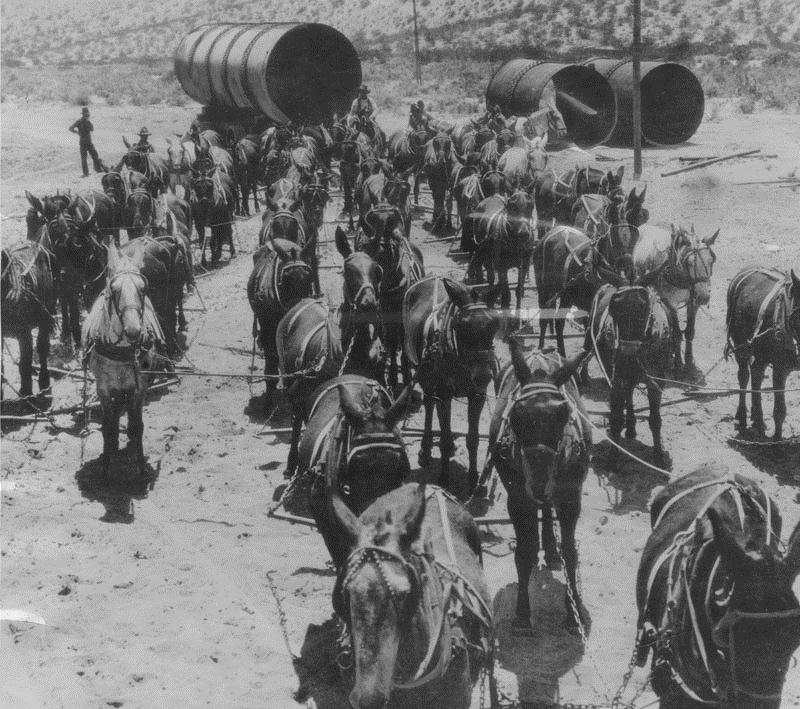 |
| (1912)* - Transportation was largely by mule power when the Los Angeles Aqueduct was under construction. This photo shows a 52-mule team hauling sections of aqueduct pipe to the Jawbone Siphon. |
Historical Background The Los Angeles Aqueduct aqueduct was designed and built by the city's water department, at the time named the Bureau of Los Angeles Aqueduct, under the supervision of the department's Chief Engineer William Mulholland. Built between 1908 and 1913 at a cost of $23 million, the LA Aqueduct tapped into the waters of the Owens River and delivered water 233-miles south to Los Angeles. When completed in 1913, the Los Angeles Aqueduct was considered to be a great engineering accomplishment only second to the Panama Canal. A century later, it continues to be a marvel in modern engineering. The LA Aqueduct brought water from the Owens Valley hundreds of miles away to a growing area in need of additional resources to sustain its people and their endeavors, helping spur an economy that today rivals that of many nations. A century later, this gravity-fed system continues to be a major source of water for Los Angeles — on an average year supplying 29% of the water needs for four million people. |
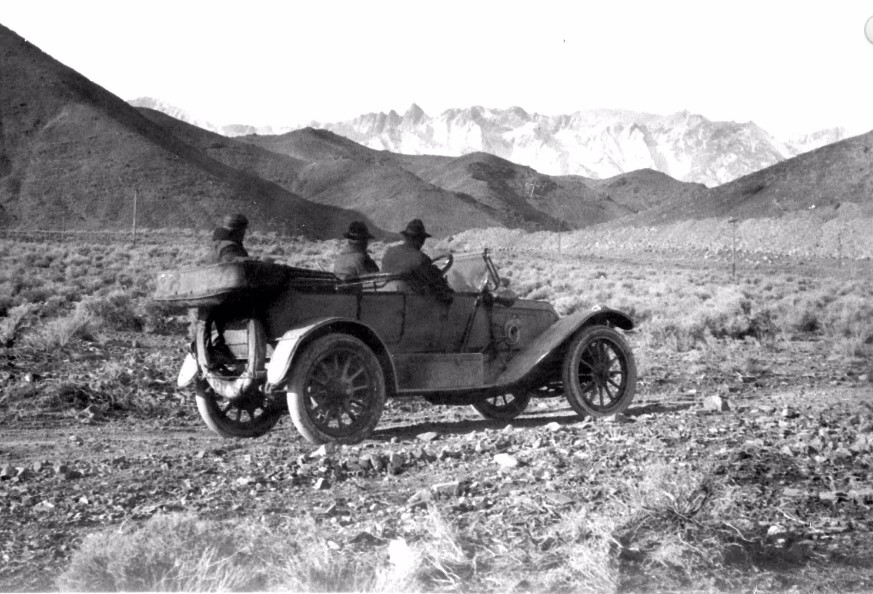 |
|
| (ca. 1906)^^*– View showing William Mulholland along with two others, sitting in a car in the Owens Valley. All three are looking toward the snow covered Eastern Sierras, water source of the yet to be built L.A. Aqueduct. |
Historical Notes In March of 1905, William Mulholland recommended to the Board of Water Commissioners that the Owens Valley was the only viable source of supplemental water for the City’s fast growing population. The following year the City submitted an application for rights-of-way across federal lands for the purpose of constructing an aqueduct. The application was approved and in 1907 Los Angeles voters approved a $23 million bond issue for the construction of the Los Angeles Owens Valley Aqueduct. Work began on the aqueduct in September and the City began to purchase private property and water rights in the southern pert of Owens Valley.^^* |
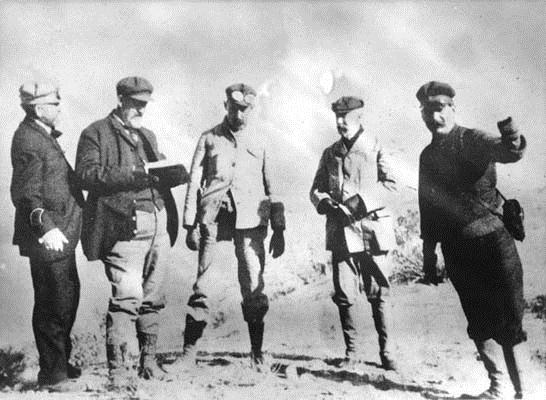 |
|
| (1906)* - The independent Board of Engineers appointed to review Mulholland’s scheme for the Los Angeles Aqueduct in the Owens Valley. From left, John R. Freeman, James D. Schuyler, Joseph P. Lippincott, Frederick P. Stearns, and William Mulholland. |
Historical Notes Seeking to diminish as much criticism as possible prior to the $24 million bond election, the Los Angeles Water Commissioners appointed an Aqueduct Advisory Board, comprised of three nationally known civil engineers: John R. Freeman, James D. Schuyler and Frederick P. Stearns. They made an independent evaluation of the proposed aqueduct. The board reviewed the project's design feasibility, constructability, pricing and logistic requirements. The Board found the aqueduct "admirable in conception and outline" in their report released during the fall of 1906. Few engineers dared to criticize the project after the panel's review was released, due in large part to the clout and credibility of John R. Freeman, one of the principal consultants for New York’s New Croton Aqueduct.^ |
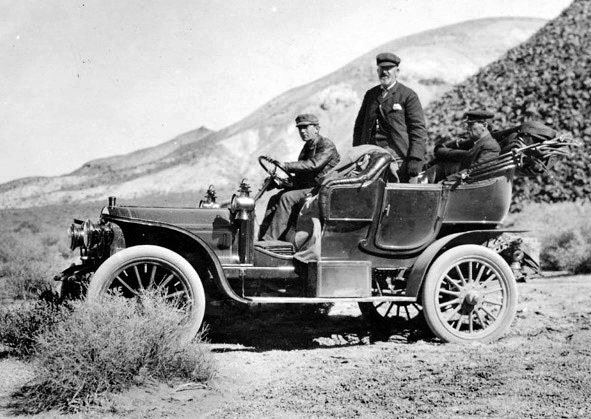 |
|
| (1906)^ – James D. Schuyler, nationally recognized Civil Engineer and member of the Aqueduct Advisory Board, looks out toward the landscape as he evaluates the feasibility of constructing the aqueduct. |
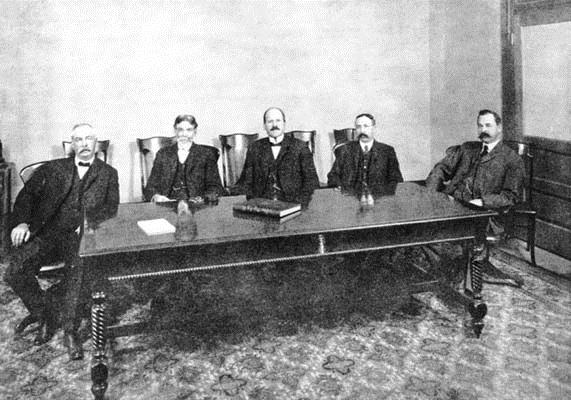 |
| The Board of Water Commissioners of the LA Department of Water and Power at the time of the building of the LA Aqueduct to Owens Valley. (L-R) John J. Fay, J. M. Elliott, Moses H. Sherman, William Mead, and Fred L. Baker. |
Historical Notes Moses Sherman served on the water board while he also participated in plans to develop the San Fernando Valley, which became the outlet point for the aqueduct. Sherman's double role has been the source of conspiracy theories with regard to the aqueduct.* |
The People Behind the Construction of the LA Aqueduct
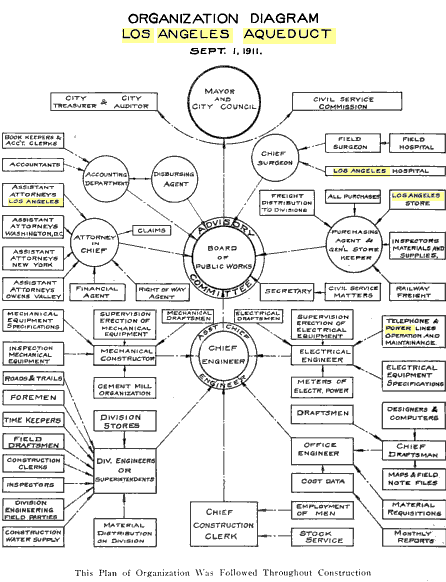 |
The Board of Public Works had charge of the expenditure of all bond moneys derived from the sale of Aqueduct and Power bonds.
William Mulholland was appointed the Chief Engineer.
J.B. Lippincott was appointed Assistant Chief Engineer. |
| (1911)**- Organizational Chart for the Construction of the LA Aqueduct. |
H. A. Van Norman was in charge of the construction work done with dredges and the building of the unlined canal on the Owens Valley division. O.W. Peterson was in charge of the construction of the open lined canal from the north end of the Alabama Hills to the Haiwee reservoir. Phil Wintz had charge of the building of the South Haiwee Dam. C. H. Richards was in charge of the construction of the covered conduits and tunnels in the Rose Valley and Little Lake divisions. F. J. Mills was Division Engineer of the Grapevine division, consisting of tunnels and pressure pipes. Louis Mesmer built the Freeman Division. A. C. Hansen completely constructed the Jawbone division and a large portion of the Mojave division. John Gray had charge of the greater portion of the construction of the Elizabeth Tunnel and the power tunnels in the San Francisquito Canyon. W. C. Aston was in charge of the south portal of the Elizabeth tunnels and steel pipe. E. F.Scattergood was Electrical Engineer in charge of construction of the power plants. Roderick MacKay had general supervision of the operation of the cement mill and of the selection and advisory of the heavy mechanical equipment. E. W. Bannister was Office Engineer in general charge of the drafting room and of the office of records. |
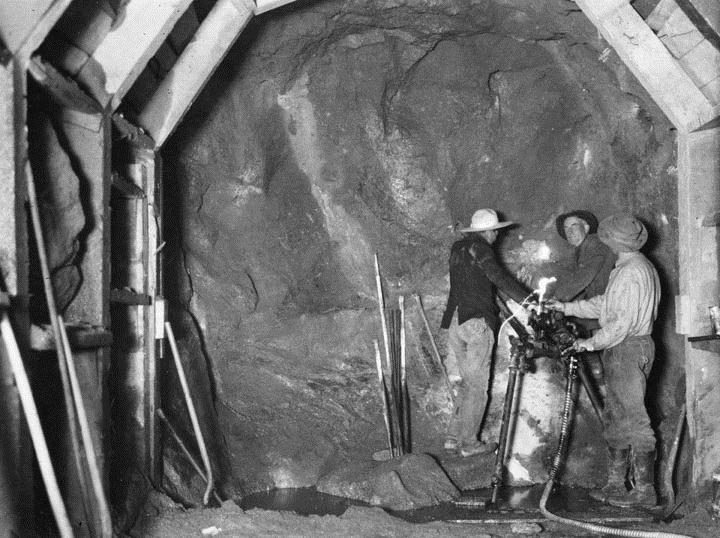 |
|
| (ca. 1908)* - View of a construction crew drilling in the Elizabeth Tunnel. |
Historical Notes The most difficult part of the construction of the LA Aqueduct was tunneling. There were 142 tunnels, totaling forty-three miles in length, that had to be dug during the five years of the aqueduct's construction. The Elizabeth Tunnel was the longest with a length of over five miles.* |
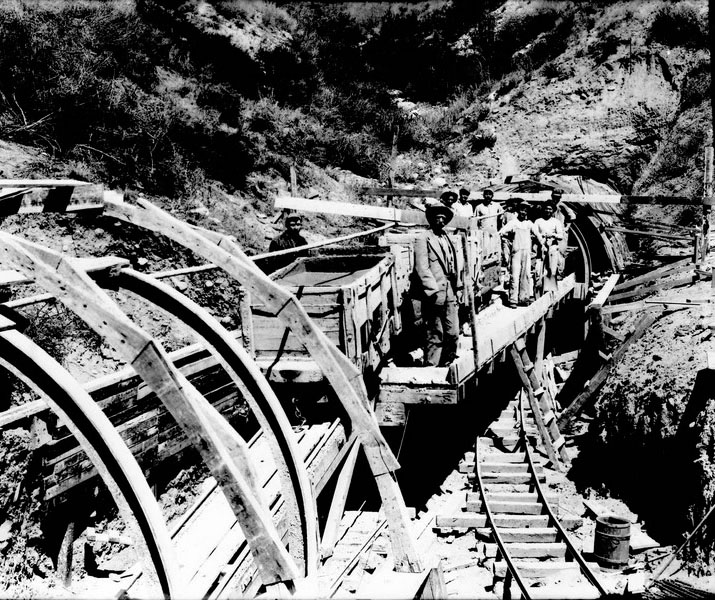 |
|
| (ca. 1908)* - Workers preparing tunnel for cement lining. |
Historical Notes In the first 11 months of work, 22 miles of tunnel were driven. The Elizabeth Tunnel set the world record for hard rock tunnel driving: 604 feet in one month. The Board of Engineers had estimated it would take five years to finish the five-mile tunnel. The men beat their deadline by 20 months.* |
 |
|
| (n.d.)* - Tunnel construction nearing completion. |
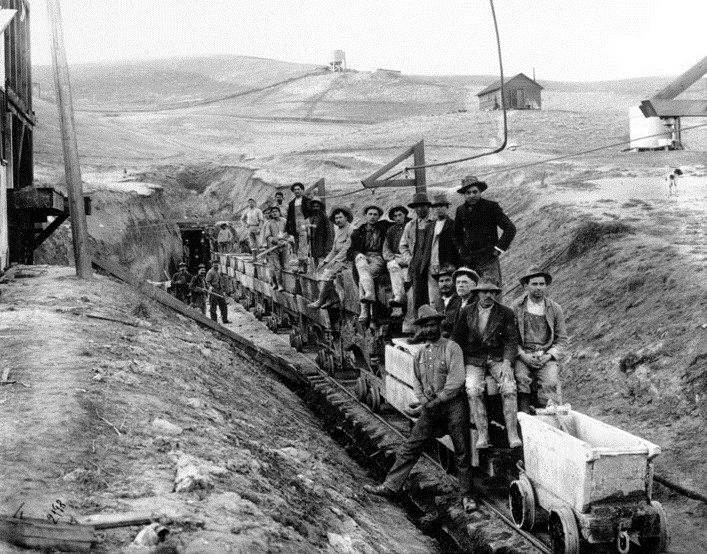 |
|
| (1908)* - Men pose in front of the Elizabeth Tunnel at Johnsville, California. |
Click HERE to see more in Tunnel Construction on the LA Aqueduct |
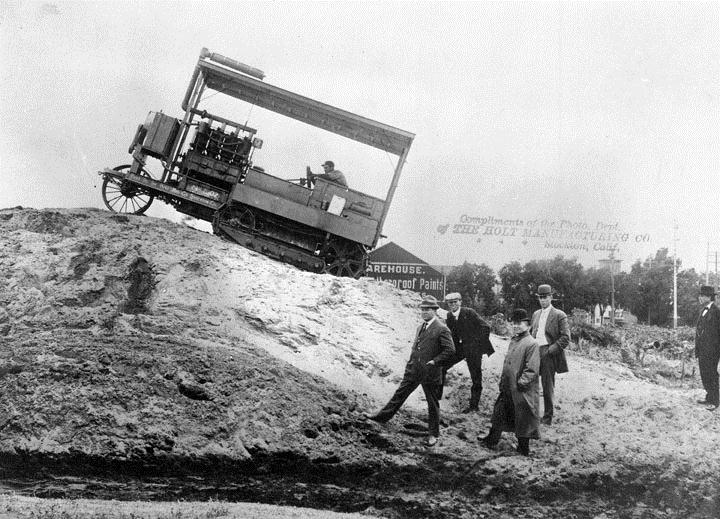 |
|
| (1907)* - The first Caterpillar tractors ever built were used to help complete the 5.5 mile Elizabeth Lake Tunnel section of the Los Angeles-Owens River Aqueduct. |
Historical Notes “It crawls like a caterpillar.” And caterpillar is its name to the present day. The descriptive remark is attributed to William Mulholland while watching the first formal demonstration of the new type of tractor just purchased for hauling materials across the desert during the building of the aqueduct.*^ |
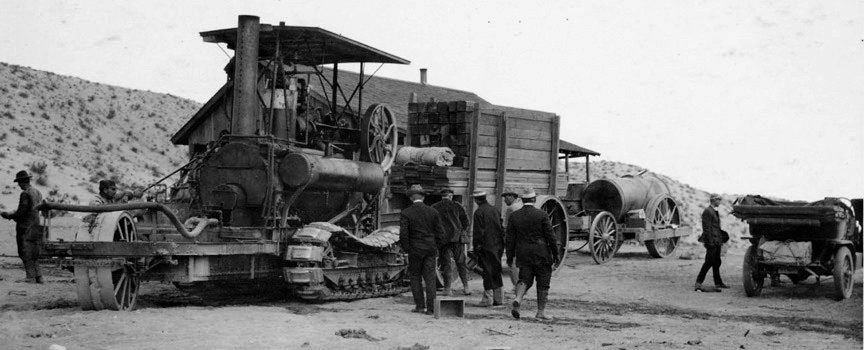 |
|
| (1908)^#^ - Caterpillar Traction Engine hauling lumber on the Mojave Desert. |
Historical Notes The Holt caterpillar traction engines looked so promising that 28 of them were purchased by the City for transporting heavy loads.*#* |
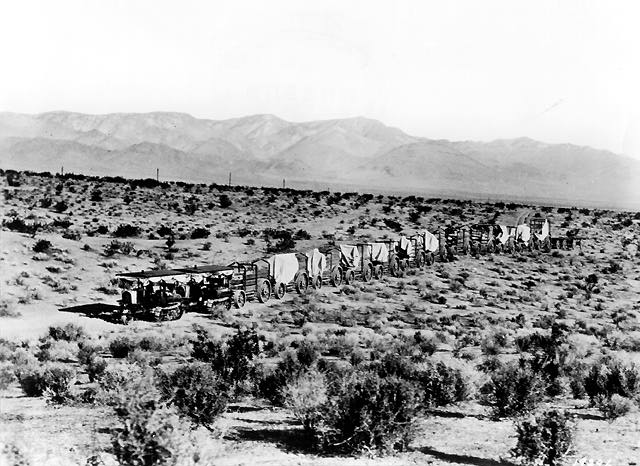 |
|
| (1909)*^* - Two Holt 45 gas crawling-type ("caterpillar") tractors team up to pull a long wagon train in the Mojave Desert during construction of the Los Angeles Aqueduct. |
Historical Notes It was hoped that the Caterpillar tractor would be a mechanical substitute for the mule – a departure from traditional construction methods that could lower costs and speed the progress of the great water way to Los Angeles. However, things didn’t quite work out that way.*^ |
 |
|
| (ca. 1910)*#* - Truck fleet and Holt caterpillar traction engine transporting materials and machinery to an aqueduct construction site. |
Historical Notes The Mojave Desert proved too much of a challenge for the caterpillar traction engines. They were plagued with frequent breakdowns and their use was soon abandoned in favor of mule teams. Some of the Holt caterpillars were used as forms when the concrete lining of the aqueduct was poured.*#* |
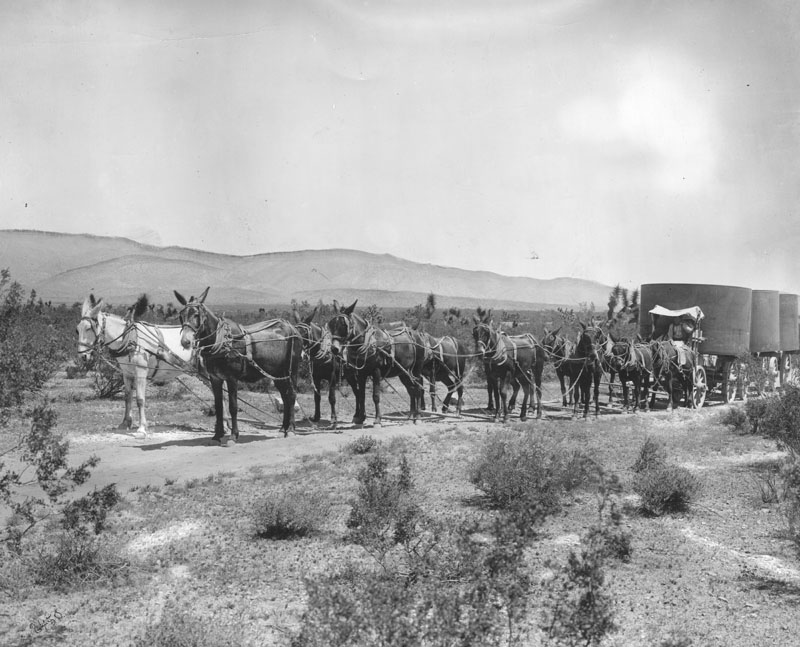 |
|
| (ca. 1910)* - Mule team hauling materials to build the Los Angeles Aqueduct. The roadless territory spanned by the $24,500,000 water system was too tough for the automotive travel of that era. |
Historical Notes City crews reverted back to using mules after maintenance and repair of the caterpillar tractor proved too costly. |
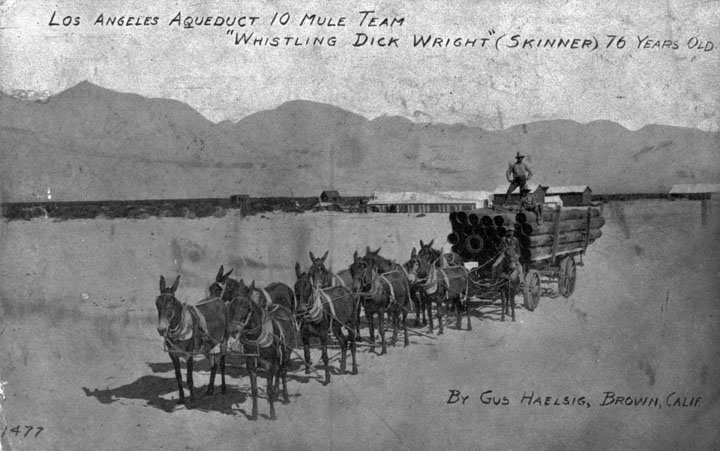 |
|
| (1912)* - Early postcard depicting 10 mule team hauling equipment during aqueduct construction. |
Historical Notes Early postcard depicting “Whistling Dick”, a 76 year old muleskinner who worked on the aqueduct; postcard was loaned for copy purposes by Department of Water and Power retiree Ed Fleming of Mojave (June 1971). Fleming stated that the picture shows Dick Wright mounted on the left wheel mule holding the jerk line, and his two swampers are atop the load of pipe. “Whistling Dick” had the makings of both myth and legend, a type of rugged individual who creates an aura of romance in stories of the Old West. Back in 1912, 74-year-old Whistling Dick drove a team of 52 balky mules as he labored with hard working crews building one of the toughest sections of the Los Angeles Owens River Aqueduct in the Mojave Desert – the spectacular jawbone Siphon, a giant roller coaster of a pipeline. What is considered to be Whistling Dick’s grave is in a small windswept cemetery about one mile southwest of Jawbone Canyon Road, located between the routes of the original and the Second Los Angeles Owens River Aqueducts. His 52-mule team wagons transported mammoth 30-ton sections of steel pipe along sun baked desert trails to the job sites. Although 20-mule teams were common, the extremely heavy aqueduct sections required the pulling power of the 52-mule teams.*^ |
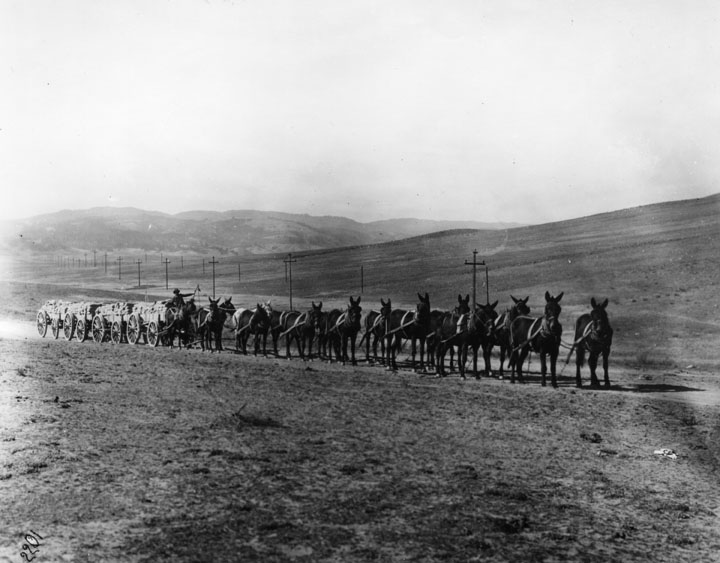 |
|
| (ca. 1912)* - A 16-mule team hauling bags of cement produced at the Monolith plant in the Tehachapi Mountains. |
Historical Notes Cement bagged at the Monolith Mill was shipped by train to the nearest railroad siding, then loaded onto wagons and transported by mule team to aqueduct construction sites.* |
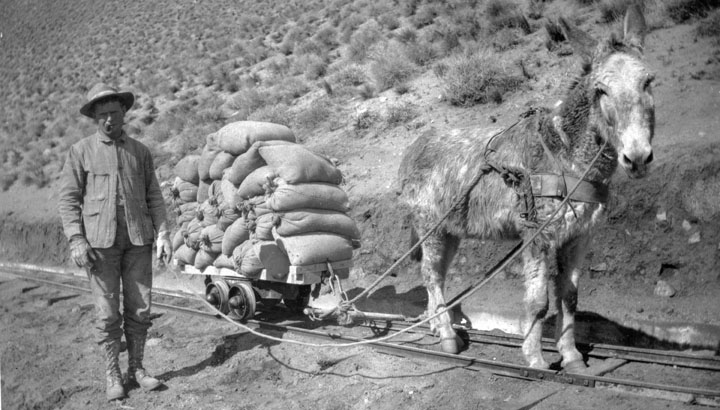 |
|
| (1908)* - Vew of a worker with mule-drawn small rail car transporting cement to a construction site. |
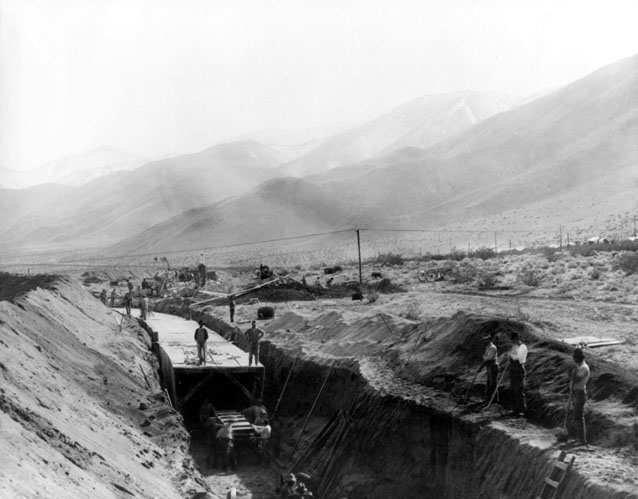 |
|
| (ca. 1910)^^^ - Forms for cement lining are being put in place at an open channel section of the LA Aqueduct. |
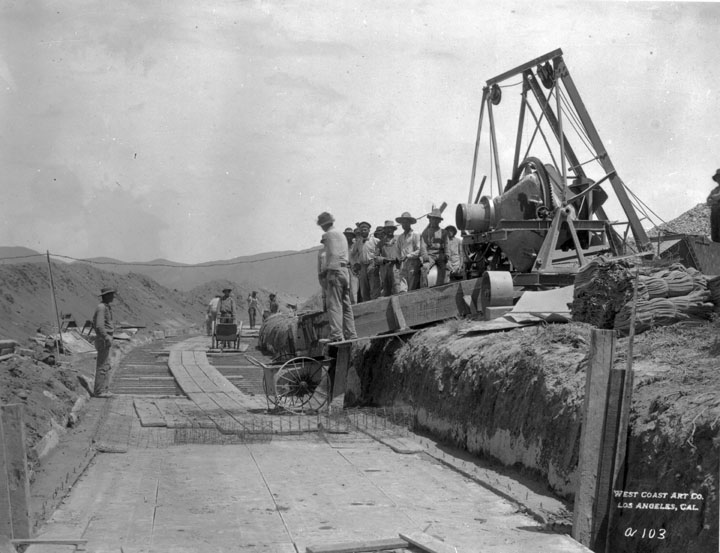 |
|
| (1908)* - Workers begin the process of cement lining the open channel portion of the LA Aqueduct. |
Historical Notes Concrete was the most prevalent construction material for the Aqueduct, although in some cases the engineers might have preferred steel pipe. The use of steel pipe was limited by its tremendous cost, a result of having to transport it to California from its place of manufacture in Pennsylvania.*^ |
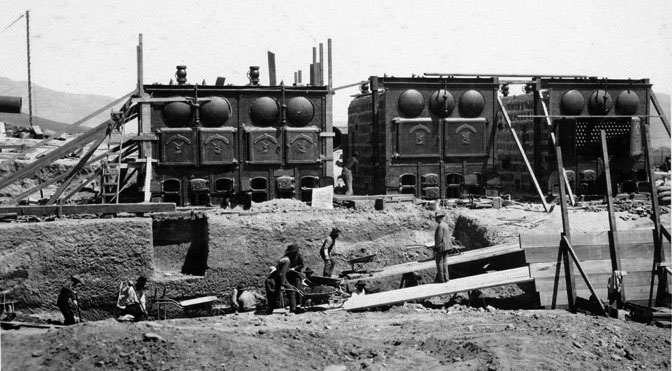 |
|
| (1908)^#^ - On-site cement plant was used for the lining of the open channel portion of the aqueduct. |
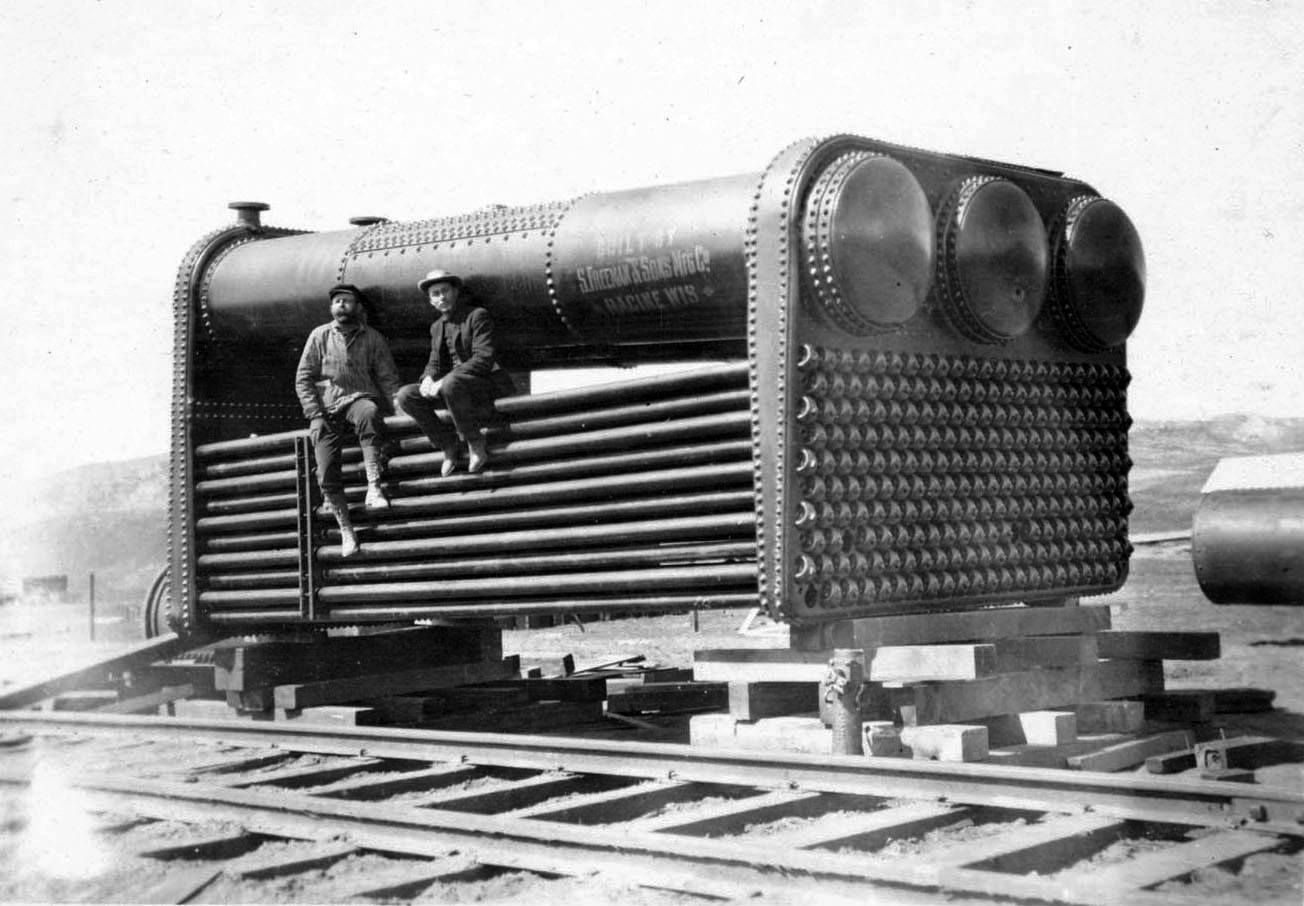 |
|
| (ca. 1908)^# - Close-up view of cement mill boilers. |
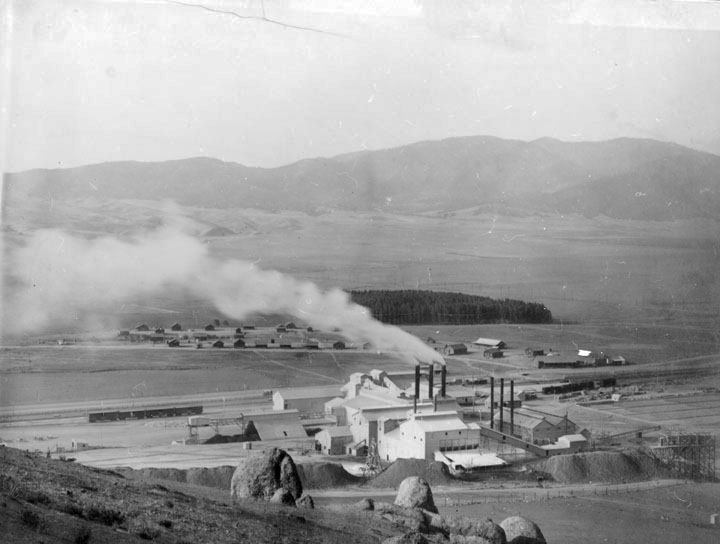 |
|
| (1909)* - View of the cement plant built for the construction of the LA Aqueduct, named Monolith. |
Historical Notes Monolith began as a camp for workers at a cement plant supplying the Owens Valley aqueduct. William Mulholland bestowed the name due to a huge limestone deposit. The Aqueduct post office opened in 1908, and changed its name to Monolith in 1910.*^* |
.jpg) |
|
| (1909)* - Closer view of Monolith where a great portion of the cement was produced for the aqueduct's construction. |
Historical Notes Cuddleback Ranch, five miles east of Tehachapi, was on the main line of the Southern Pacific. There the city found the materials for making 1000 barrels of Portland cement a day. They purchased 4,300 acres of land covering limestone quarries, clay deposits, and deposits of tufa also used for making concrete. In addition to the cement produced at the Monolith Mill built at Cuddleback Ranch, the City also used 200,000 barrels of cement bought from other sources.*^ |
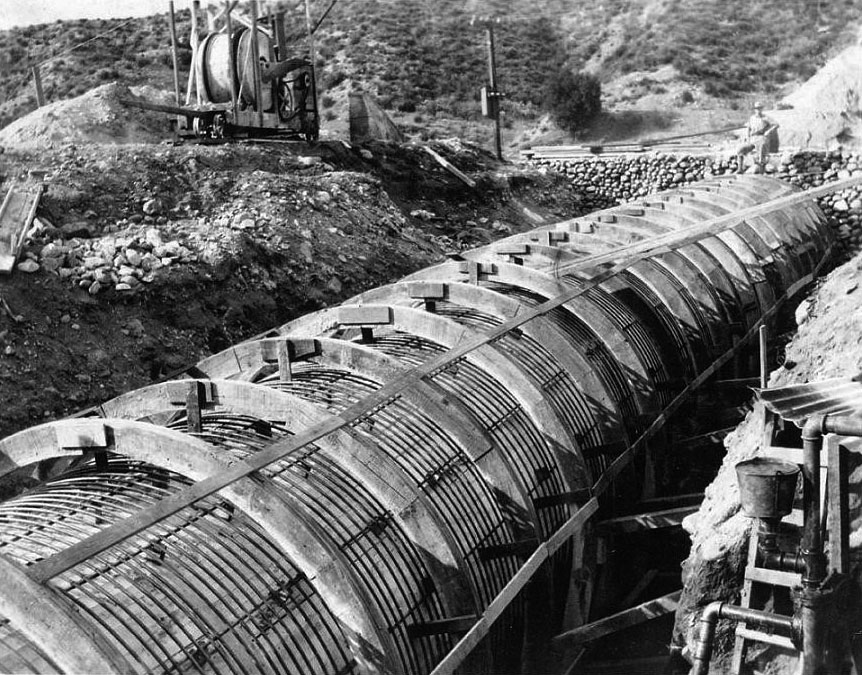 |
|
| (1909)^ – View showing Whitney siphon for the L.A. Aqueduct under construction. |
Historical Notes Whitney Canyon construction started in 1909. The section of the aqueduct through Whitney and Elsmere Canyons is noteworthy for its use of concrete in the siphon rather than the more usual riveted steel construction. |
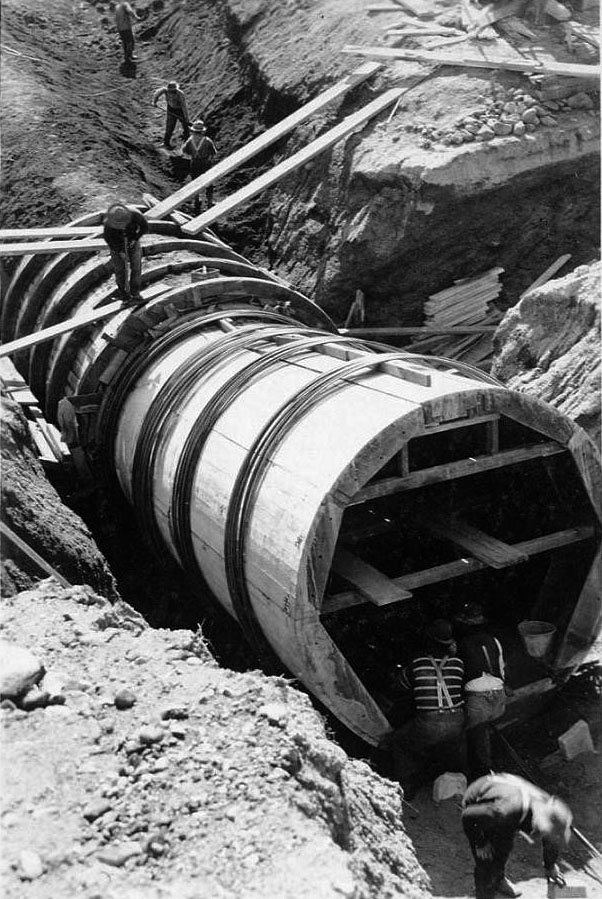 |
|
| (1909)^ – Close-up view showing construction of the Whitney siphon - Saugus Division. |
Historical Notes From the Sixth Annual Report of the Bureau of the Los Angeles Aqueduct (July 1911): The Whitney Siphon is a reinforced concrete pipe 10 feet in diameter, with an 8-in shell on the top and sides, and rests on a broad concrete base. The pipe was cast in position. The reinforcing steel consists of half-inch circular iron rods so spaced as to give a factor of safety of four on the steel. It is probable, however, that the concrete alone has sufficient strength to resist the bursting pressure, as the mixture was made very rich to obtain both water tightness and strength. Two expansion joints were put in this pipe. They are of the "Z" type and coated with asphalt paint. The only apparent leakage that has occurred at any place in the pipe is at one of these joints. In the Elsmere Siphon, which was built subsequently, no expansion joints were used. As far as known, in diameter these are the largest reinforced concrete pipes in the United States, but larger ones have been built in Spain. |
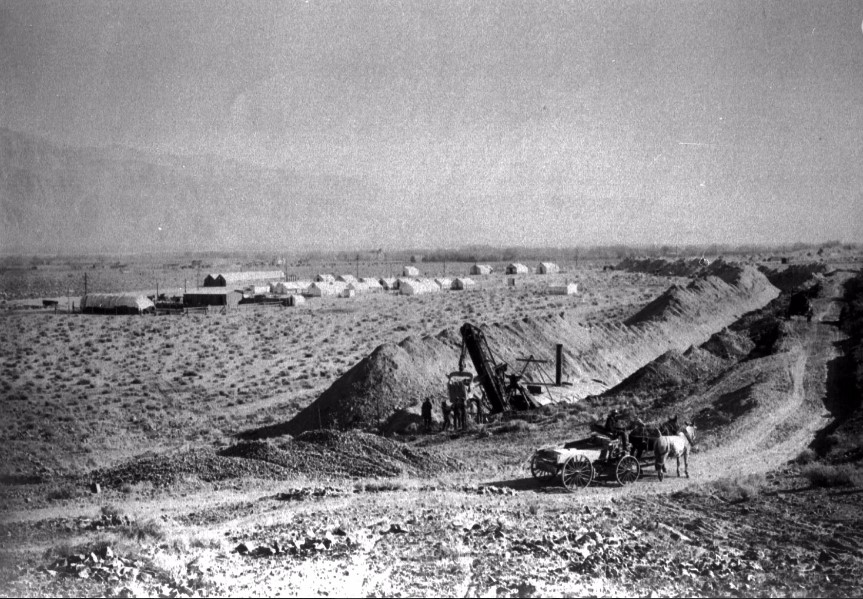 |
|
| (1912)* - A view of early excavation during the building of the LA Aqueduct to Owens Valley, done between 1907 and 1913. Here we see construction of ditches in the foreground, and the workmen's camp in the background. |
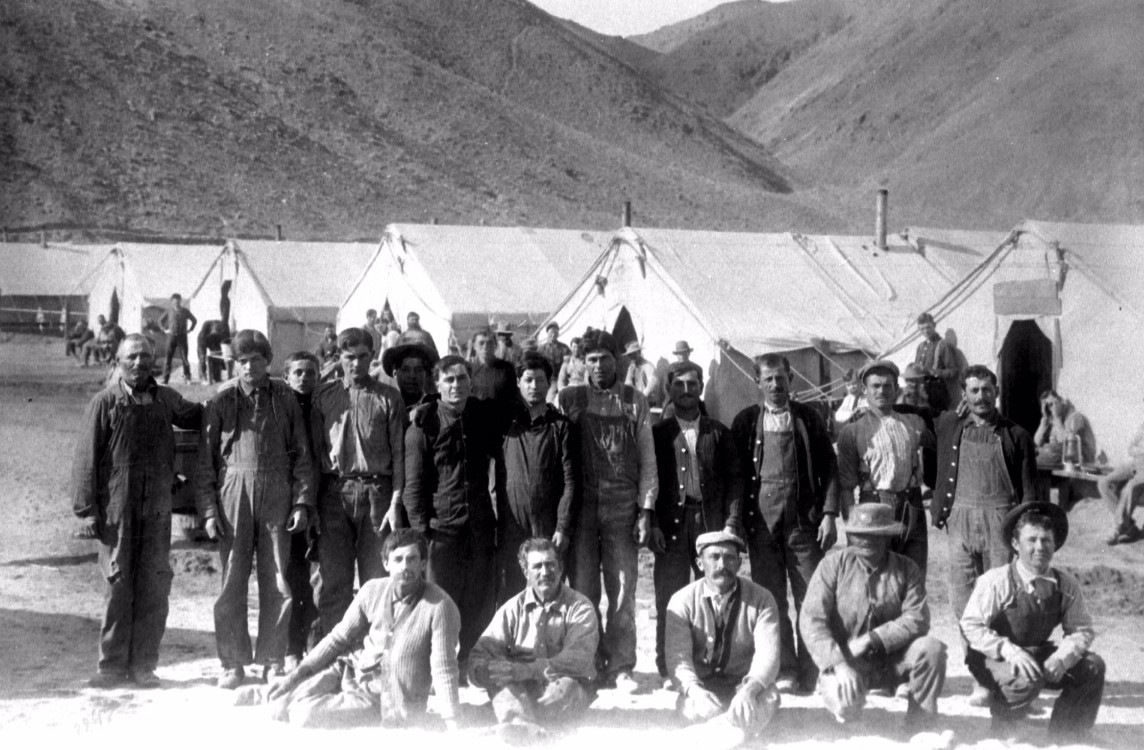 |
|
| (ca. 1912)^*– Group photo of workers posing in front of their living quarters before the start of a long workday. |
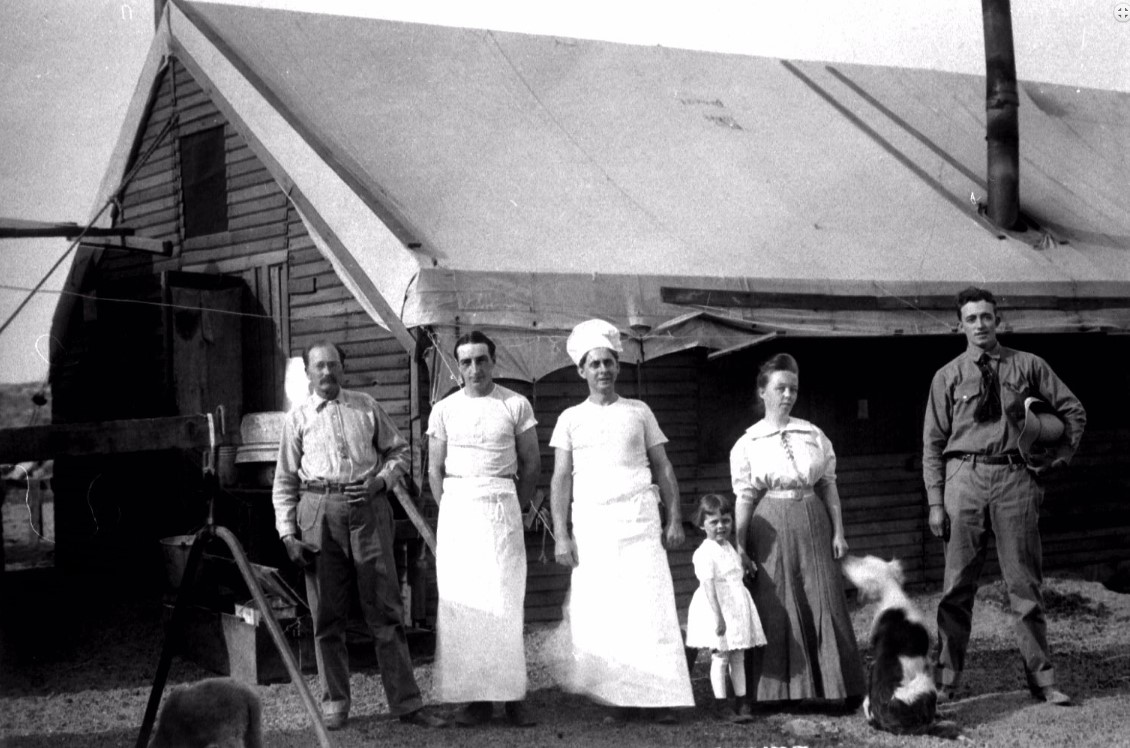 |
|
| (ca. 1912)^*– View showing some of the cooks and possibly family posing in front of the mess hall. |
 |
|
| (1910)*^# - Construction of the aqueduct pipe in the Mojave Desert. |
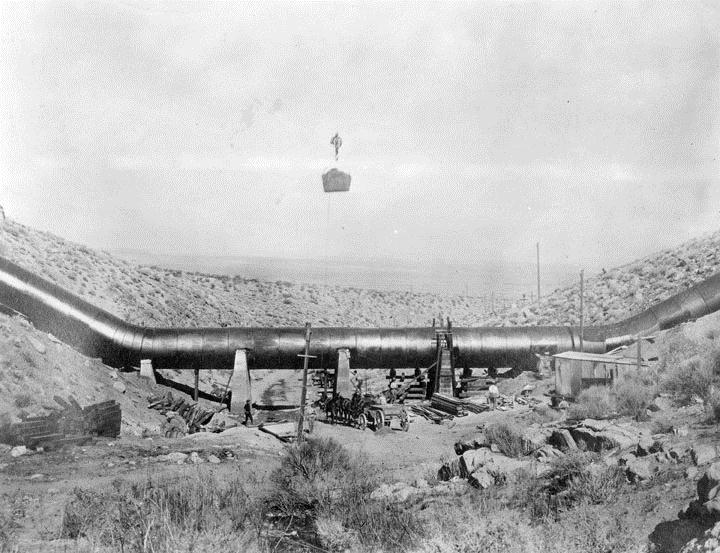 |
|
| (ca. 1912)* - Due to the extreme pressure caused by water running down the canyons, the sag pipes needed to be supported by huge concrete pillars. |
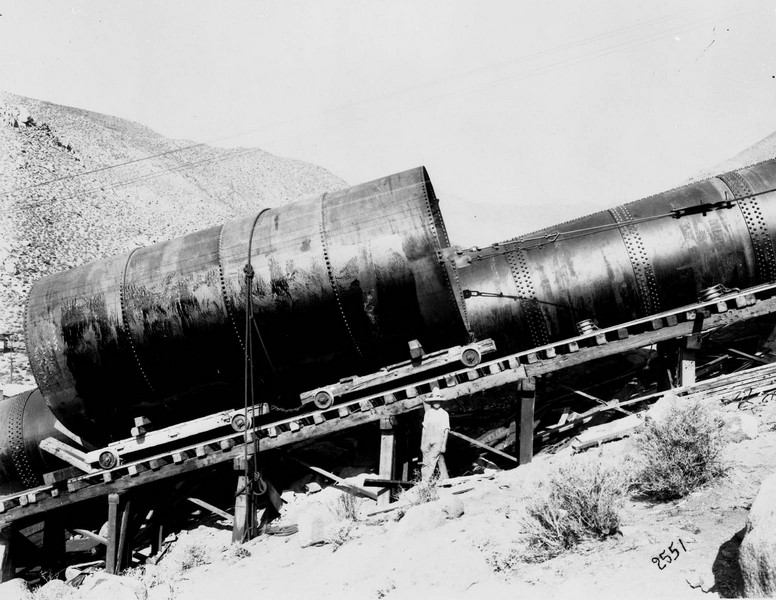 |
|
| (ca. 1912)* - View shows one of the methods used for hauling pipe sections up the steep canyons. |
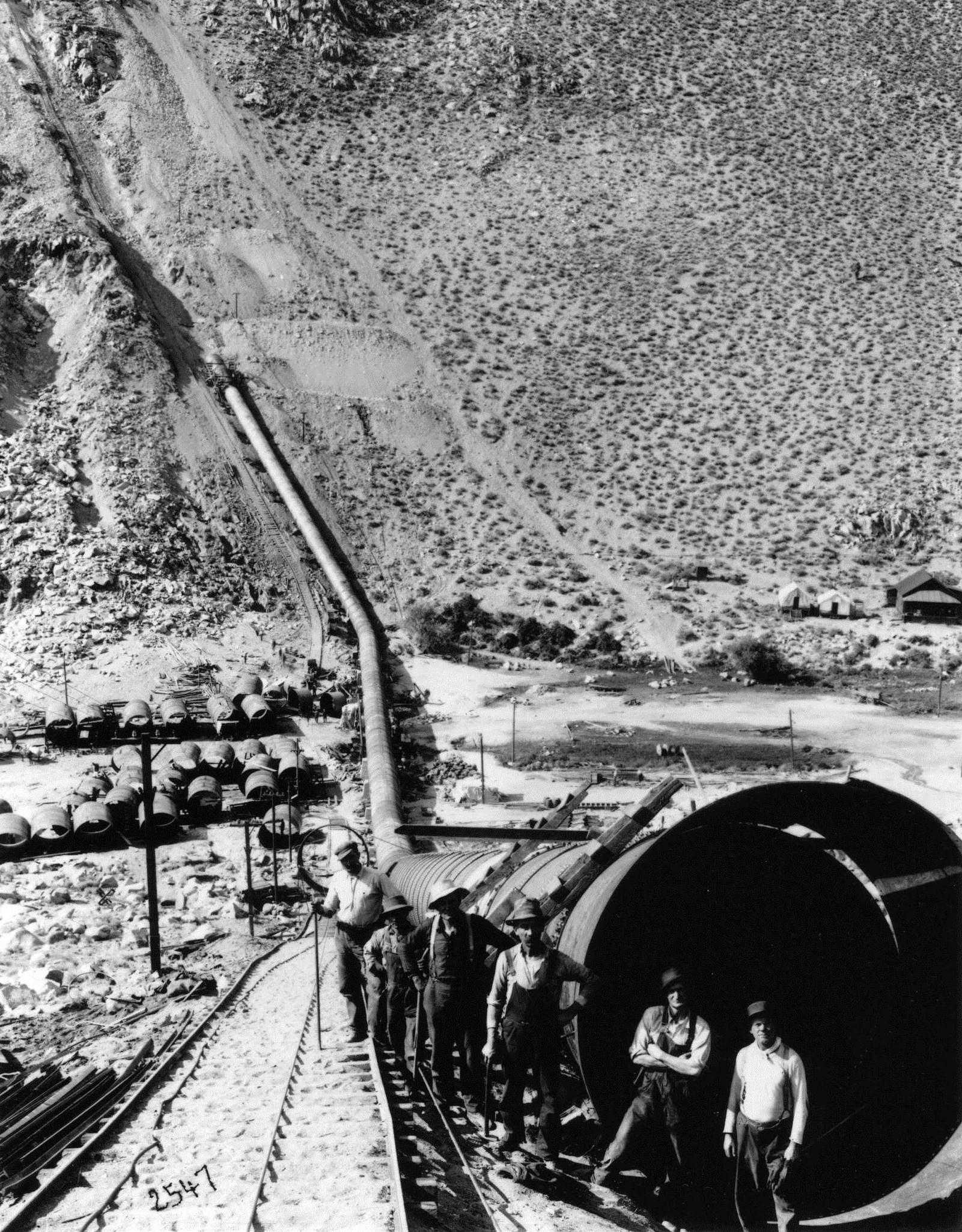 |
| (ca. 1912)* - A view of workmen posing in front of a new section of the aqueduct pipeline. |
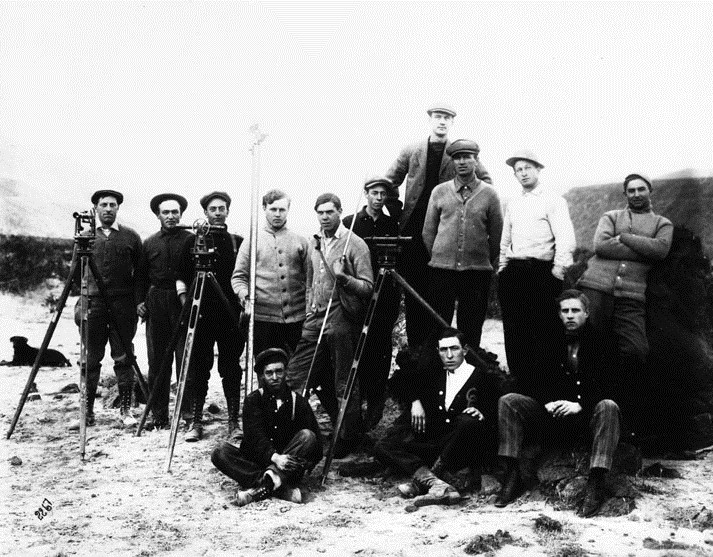 |
|
| (n.d.)* - Surveying crew during the LA Aqueduct construction. |
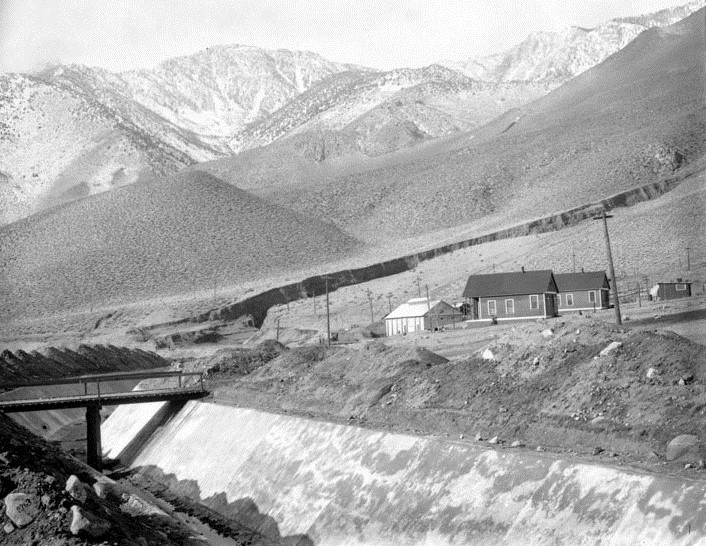 |
|
| (ca. 1908)* - Cottonwood Power Plant started generating 900 kilowatts of hydroelectric power along the Los Angeles Aqueduct on November 13, 1908, supplying energy to run equipment during the Aqueduct construction from Owens Valley through the Mojave Desert. |
Historical Notes Power from Cottonwood’s first generator and a second 900-kilowatt unit placed into service October 13, 1909, first traveled over temporary transmission lines to power the Aqueduct dredging operations and later to power equipment at the Monolith cement plant near Mojave which produced millions of tons of cement for miles of the Aqueduct’s concrete-lined conduit and canal sections.*^ |
Click HERE to see more in Electricity on the Aqueduct |
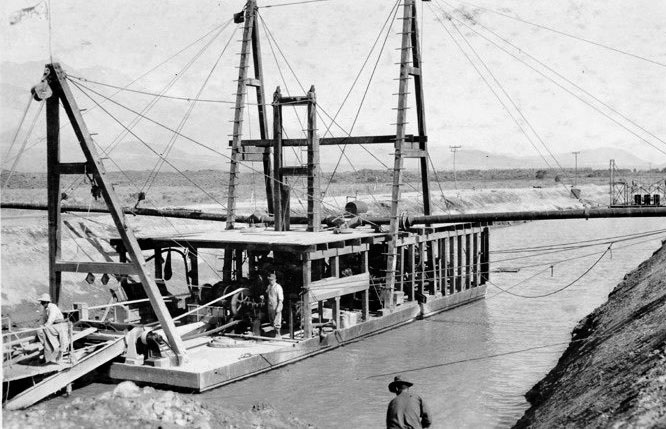 |
|
| (1908)^#^ - Dredge No 1 in 1908. The dredge got its power through electric lines running from nearby Cottonwood Power Plant. |
Historical Notes The electric-powered dredge was used to work on the 21-mile stretch of unlined Aqueduct, from the Intake across from Aberdeen to the Alabama Gates, north of Lone Pine.^*^ |
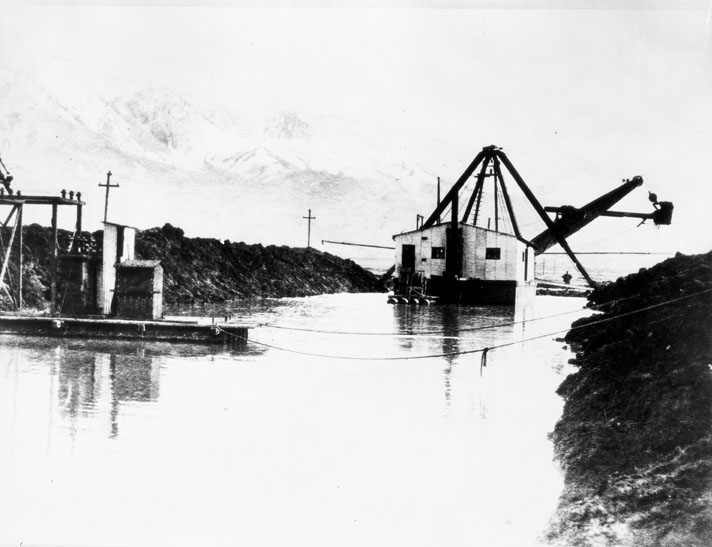 |
|
| (1911)* - Dipper dredge working in main canal, Owens Valley. |
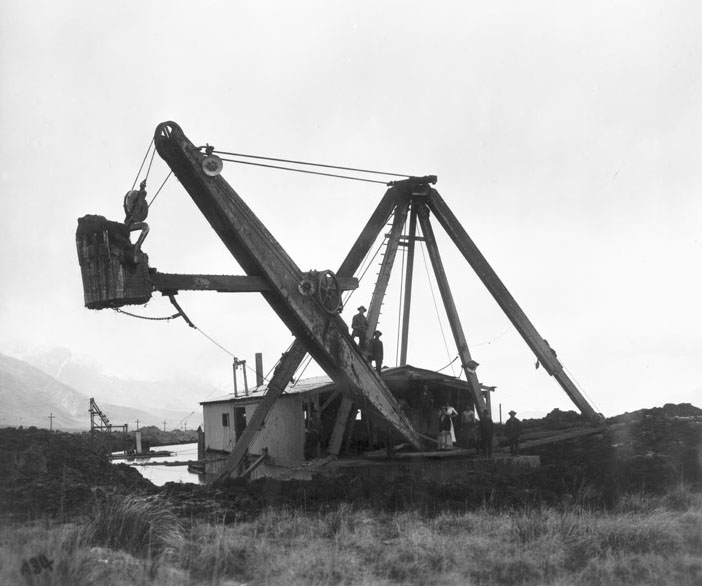 |
|
| (1911)* - Electric-powered dredge working in main canal, Owens Valley. |
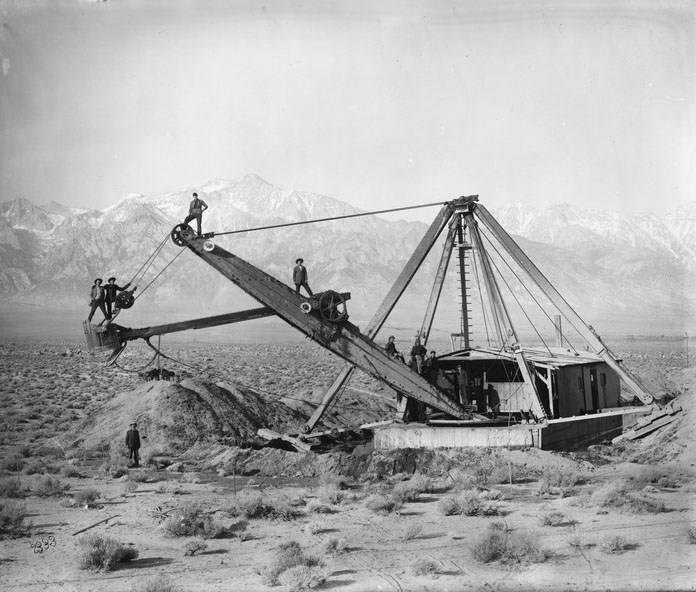 |
|
| (ca. 1910)* - The electric dredge displaced millions of cubic feet of earth in construction of the LA Aqueduct. |
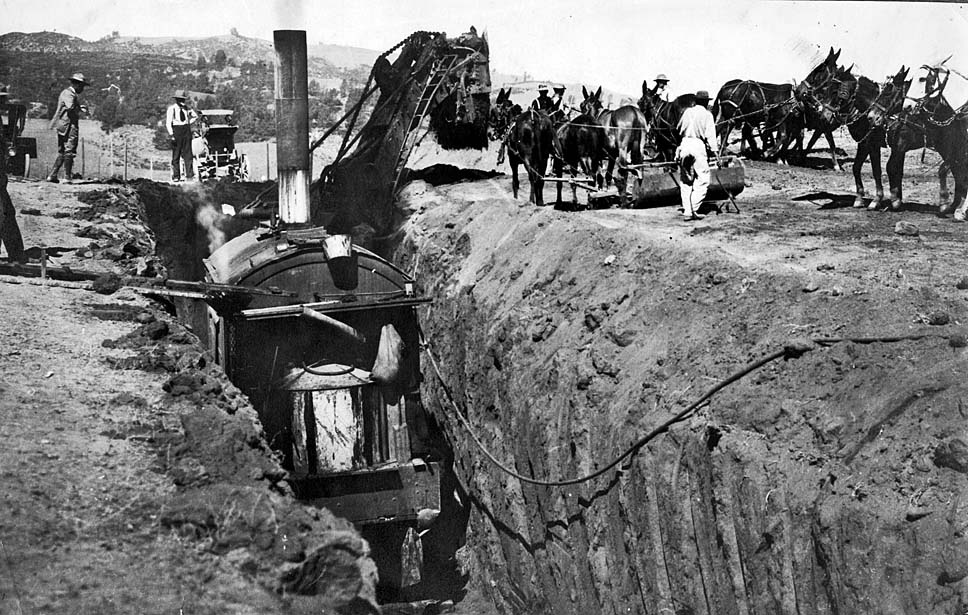 |
|
| (ca. 1911)*# - Men in steam shovels work in conjunction with mule teams during the excavation process. |
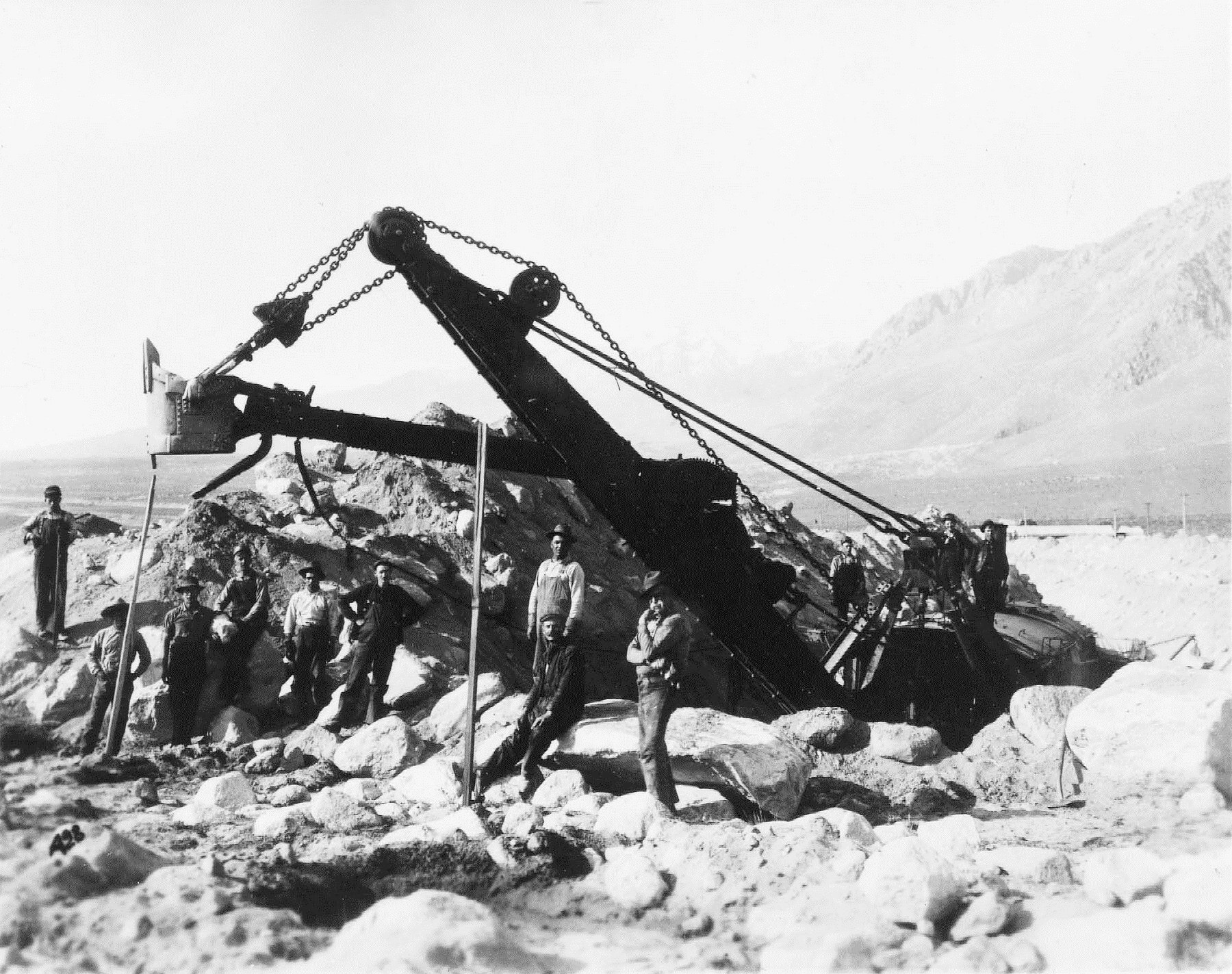 |
| (ca. 1912)* - Marion steam shovel excavating the open concrete-lined section of the Los Angeles Aqueduct in southern Owens Valley. |
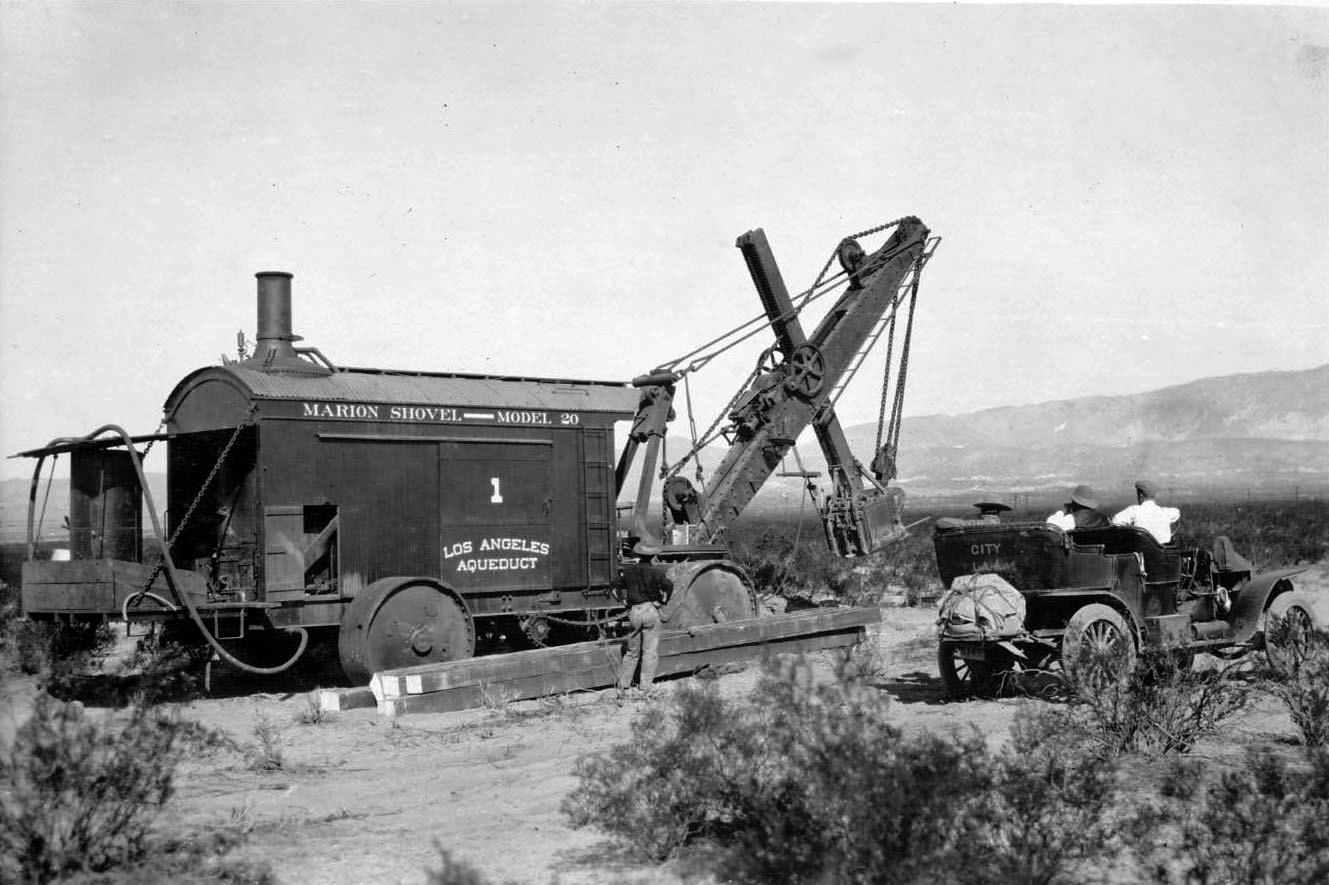 |
|
| (ca. 1912)^# - Close-up view of steam shovel No. 1 next to early model car. |
 |
|
| (ca. 1912)* - Labor crew by steam shovel No. 2 posing for the camera. |
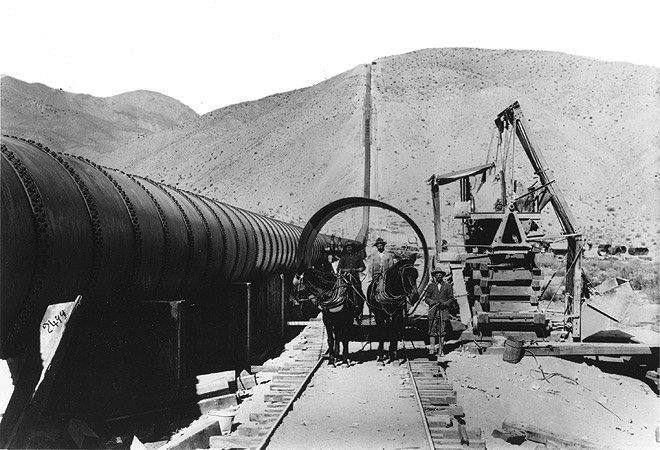 |
|
| (ca. 1912)* - Photo of a team of mules pulling a section of the aqueduct pipleine on a rail. |
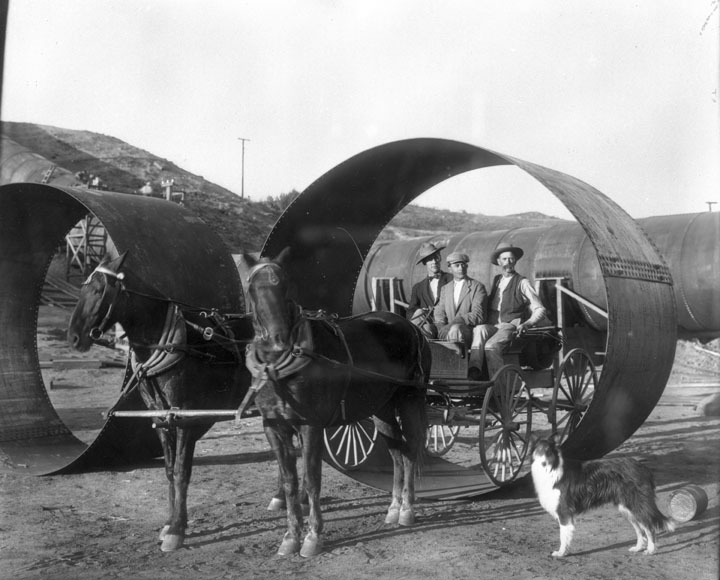 |
|
| (n.d.)* - To emphasize the size of the Aqueduct pipe, three men on a horse-drawn wagon are positioned within a pipe section. It appears the dog in the photo is also posing for the camera. |
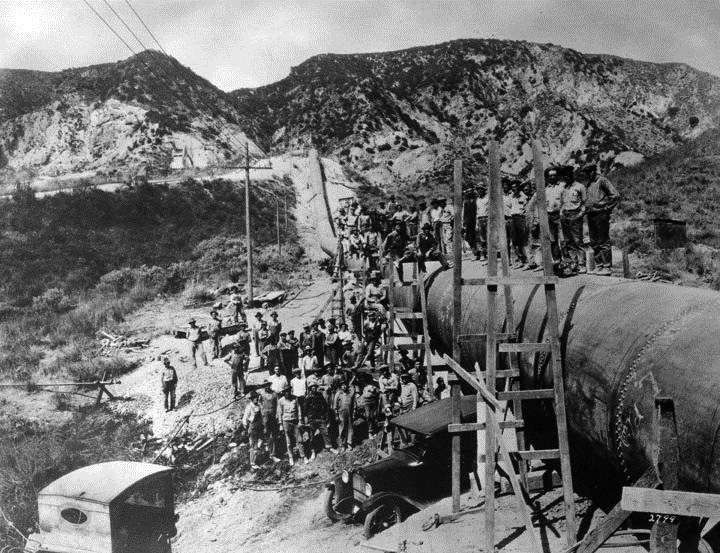 |
|
| (ca. 1912)* - A view of the workmen on the aqueduct pipeline. Power lines can be seen on the left. |
Historical Notes Two hydroelectric plants, Division Creek and Cottonwood, were built to provide electric power for construction work along the aqueduct from the intake to Mojave. Something like this had never been done before in one project. The power was used in many facets of the construction, non more important than electric dredges and the cement mills in Monolith.*^ |
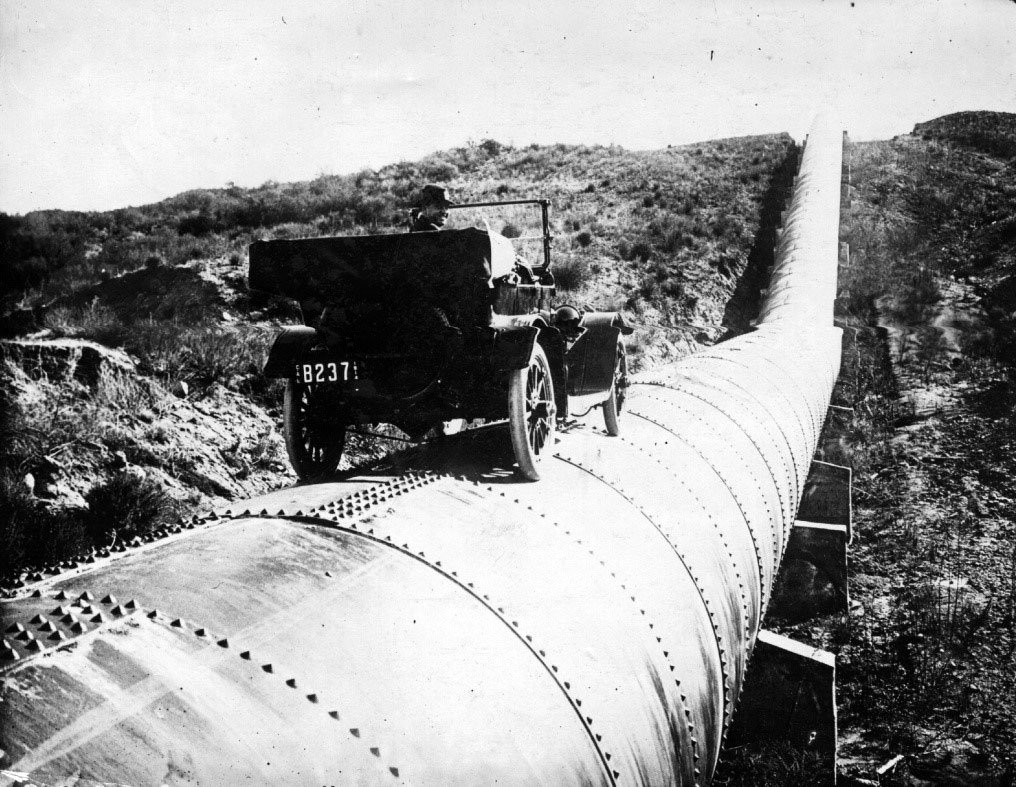 |
|
| (ca. 1913)*^^ - A man is seen behind the wheel of an early model car sitting on top of a completed section of the LA Aqueduct. |
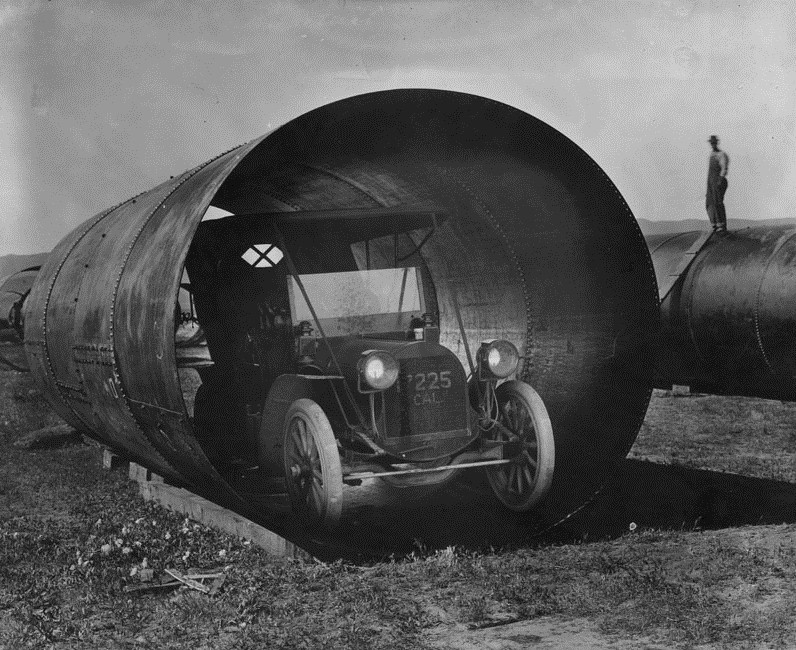 |
|
| (ca. 1913)* - An automobile fits into a section of siphon pipe used in the Los Angeles Aqueduct. |
Historical Notes The pipe was manufactured on the East Coast in 36-foot-long sections, each weighing more than 25 tons. The sections were transported by train to Cinco. From there, they were loaded onto huge wagons and carted the final four miles by teams of 52 mules.*^ The town of Cinco was founded as a work camp in the early 1900s for workers on the Los Angeles Aqueduct. |
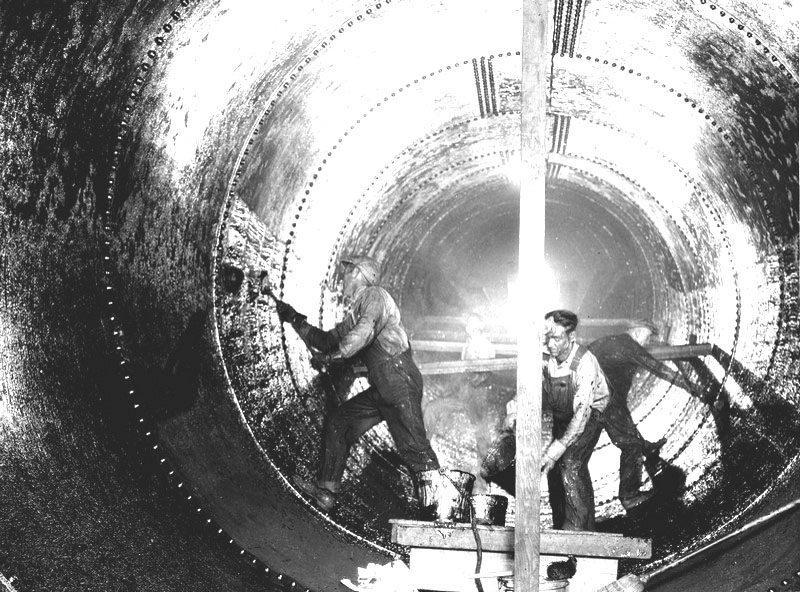 |
|
| (n.d.)#* - Workers prepare aqueduct pipe. |
Historical Notes Approximately 191,785 rivets, varying in diameter from 5/8" to 1-1/4", were usd in construction--each rivet weighs 5 pounds.*^ |
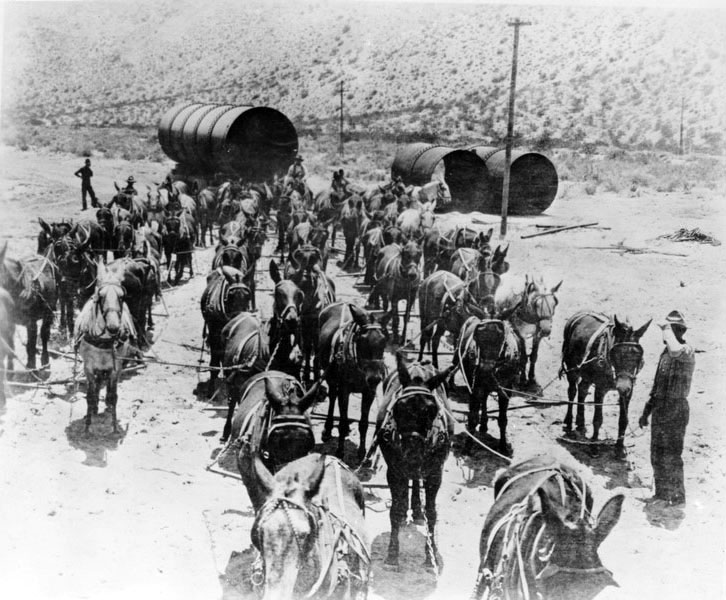 |
| (1912)* - 52-mule team hauling sections of aqueduct pipe to the Jawbone Siphon. |
Historical Notes Each 36-ton section of steel pipe was hauled 4 miles from Cinco to Jawbone Canyon by a team of 52 mules.*^ |
.jpg) |
|
| (1912)*#* - A 52-mule team, six abreast at the wheel, transporting a 30-ton section of steel pipe during construction of the Jawbone Siphon. |
Historical Notes Most of the 15,000 tons of siphon steel needed for the aqueduct was transported by 52-animal teams driven by three freighters and two swampers.*#* |
 |
|
| (1912)^#^ - 52 Mule Team hauling pipe for the Jawbone section of the Los Angeles Aqueduct in the Mojave Desert. |
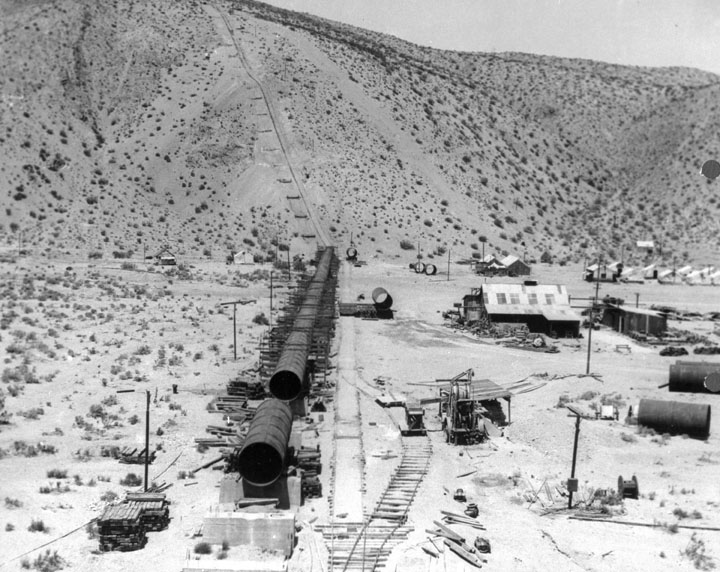 |
|
| (1912)* - Construction of the Jawbone Siphon section of the LA Aqueduct. |
Historical Notes The construction of 12 miles of steel siphon in the Aqueduct provided some of the greatest challenges. In a canyon 120 miles north of Los Angeles, the aqueduct’s engineers designed their most imposing work, an 8,095 foot steel pressure siphon across desolate Jawbone Canyon.*^ |
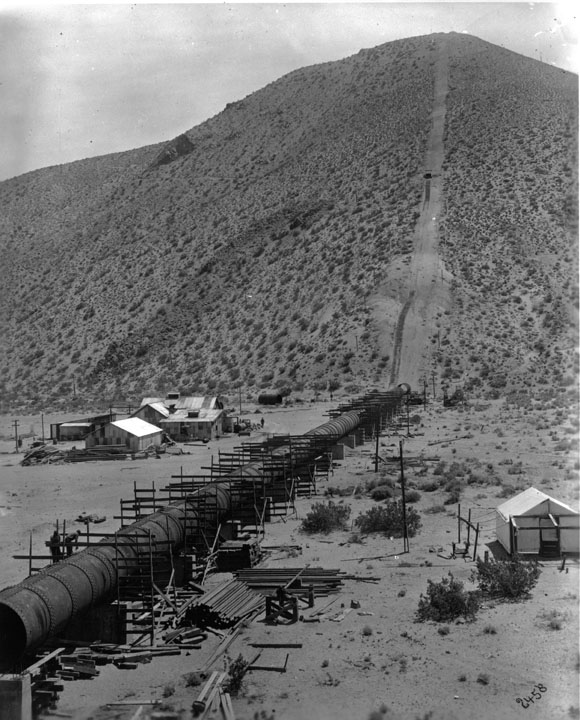 |
|
| (1912)* - The Jawone Siphon begins to take shape. |
Historical Notes The spectacular Jawbone Siphon in the Mojave Desert, a giant roller coaster of a pipeline, was one of the toughest sections to build. Construction started in January 1912 and was completed in March 1913. |
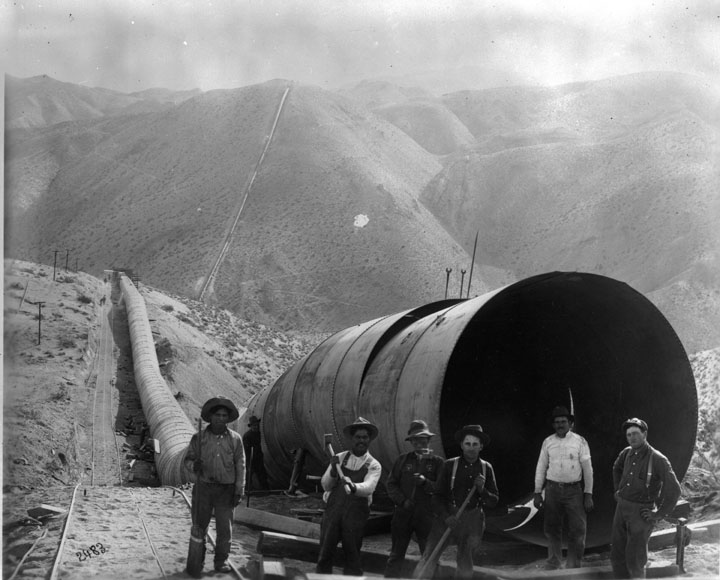 |
|
| (1913)* - View showing the Jawbone Siphon from north end. |
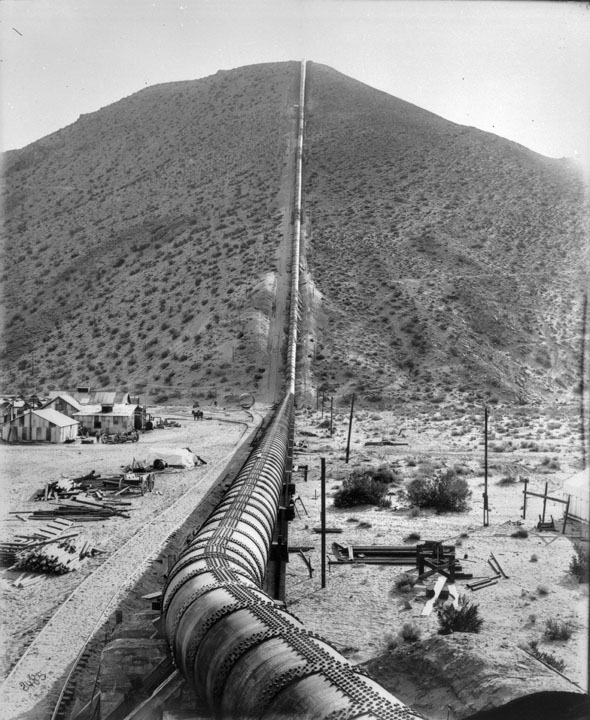 |
|
| (1913)* - View of the almost completed pipeline in the Jawbone Siphon of the Los Angeles Aqueduct. |
Historical Notes The Jawbone Division of the LA Aqueduct begins at Red Rock Summit at an elevation of 3,320.00 feet and extends to the Pinto Hills at an elevation of 3,171.00 feet. The length is 119,795 feet, of which 60,657 feet is canal, 43,658 feet is in tunnel and 15,480 feet consists of flumes and siphons. The total fall consumed is 148.96 feet.*^ |
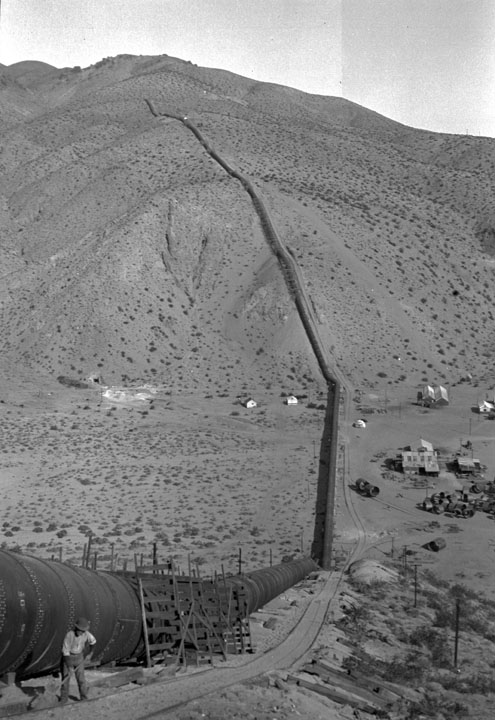 |
|
| (1913)* - View from near the top of the hill of the Jawbone Section. |
Historical Notes The Jawbone Sag Pipe was designed to handle 368 pounds per square inch of pressure at the bottom of the 1,000-foot deep canyon.*^ |
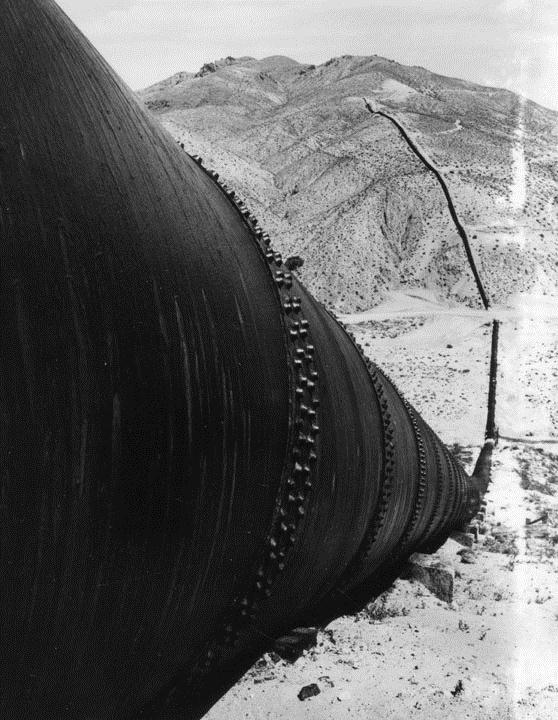 |
View showing one of the "sag pipes" of the Los Angeles Aqueduct in Jawbone Canyon. The aqueduct is based on gravity flow that does not require pumping or siphoning. Instead, water is conveyed via pressure developed in the down slope to force the water through the up slope. Jawbone Canyon is located just west of Highway 14, south of Randsburg Red Rock Road in Kern County. This section of the aqueduct, built in 1913, was designed by William Mulholland. |
|
| Jawbone Canyon Section of the Los Angeles Aqueduct |
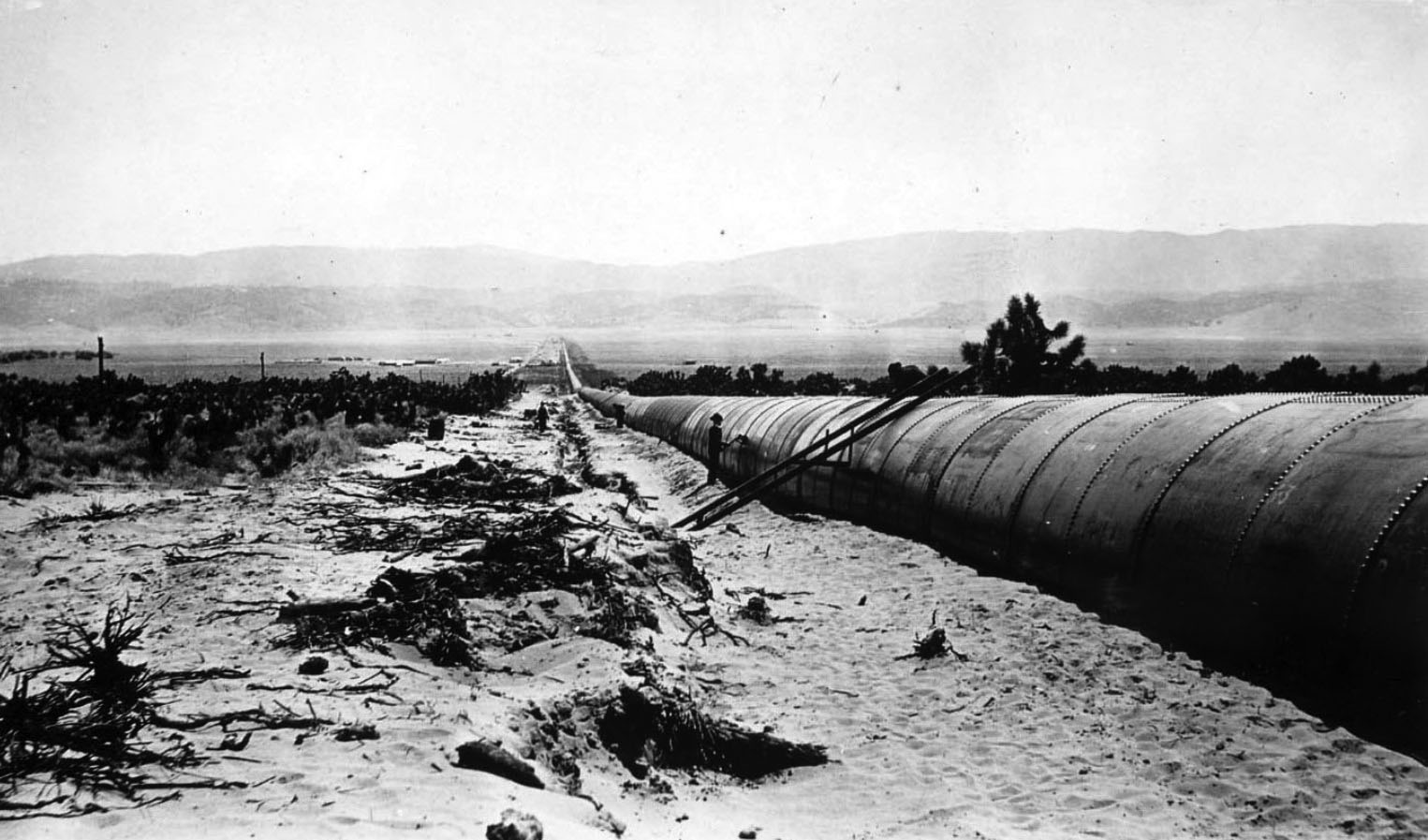 |
|
| (ca. 1913)^# - View showing the longest section of steel pipe along the aqueduct, running through Antelope Valley. |
Historical Notes The longest siphon on the aqueduct is the pipe crossing Antelope Valley. It is 21,767 feet in length, and up to heads of 80 feet is built of concrete, the remaining 14,497 feet being steel pipe. The concrete and steel pipes are both 10 feet in diameter. The maximum head on this siphon is 200 feet, and the weight of the steel is 3,511 tons.^^ |
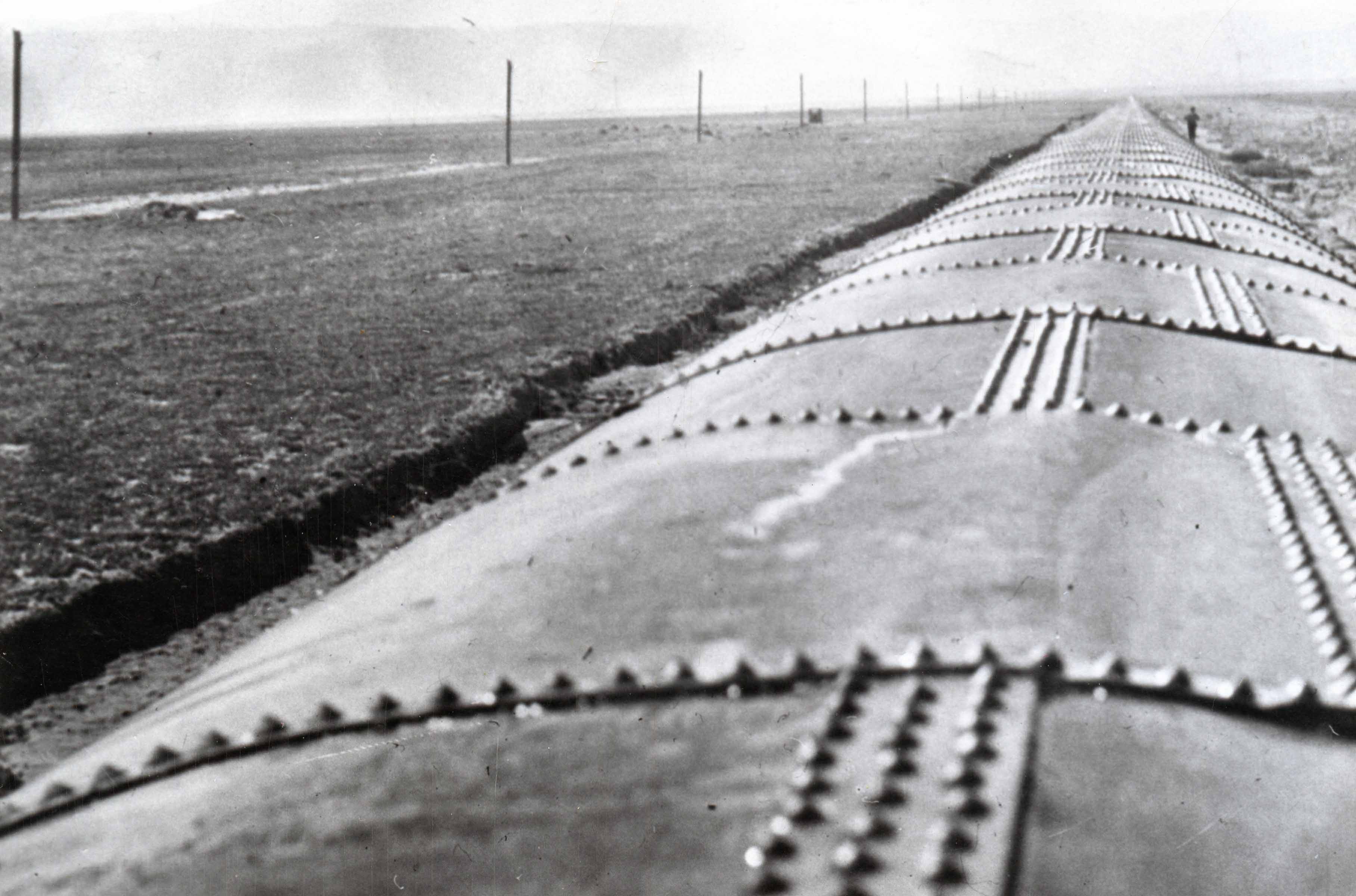 |
|
| (ca. 1913)*^ - Close-up view of the longest section of steel pipe along the aqueduct in Antelope Valley. |
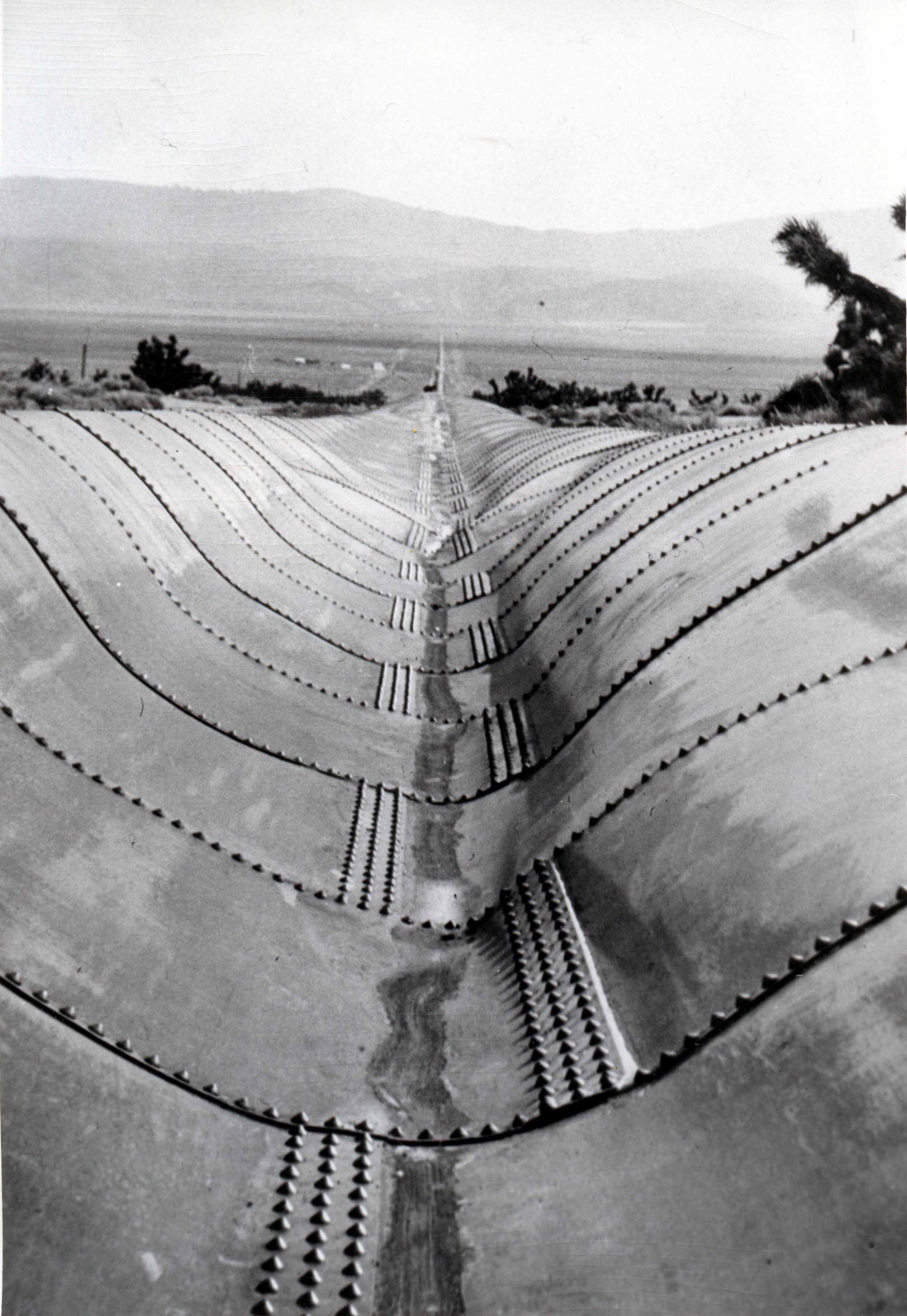 |
(1914)*^ - View showing the damaged aqueduct pipeline through Antelope Valley resultng from a major 3-day storm in February, 1914 (3-months after the aqueduct's official opening).
|
Historical Notes In February, 1914, the rainfall in the Mojave Desert region exceeded by nearly fifty per cent in three days the average annual precipitation. Where the steel siphon crosses Antelope Valley at the point of the greatest depression, an arroyo or run-off was indicated that fifteen feet was the extreme width of the flood stream, and the pipe was carried over the wash on concrete piers set just outside the high water lines. The February rain, however, was of the sort known as a cloud-burst, and the flood widened the wash to fifty feet, carried away the concrete piers, and the pipe sagged and broke at a circular seam. The steel pipe collapsed like an empty fire hose for nearly two miles of its length. In some places the top of the pipe was forced in by atmospheric pressure to within a few inches of the bottom. Many engineers pronounced the collapsed pipe a total loss, and advised that it be taken apart, the plates re-rolled and the siphon rebuilt.^^ |
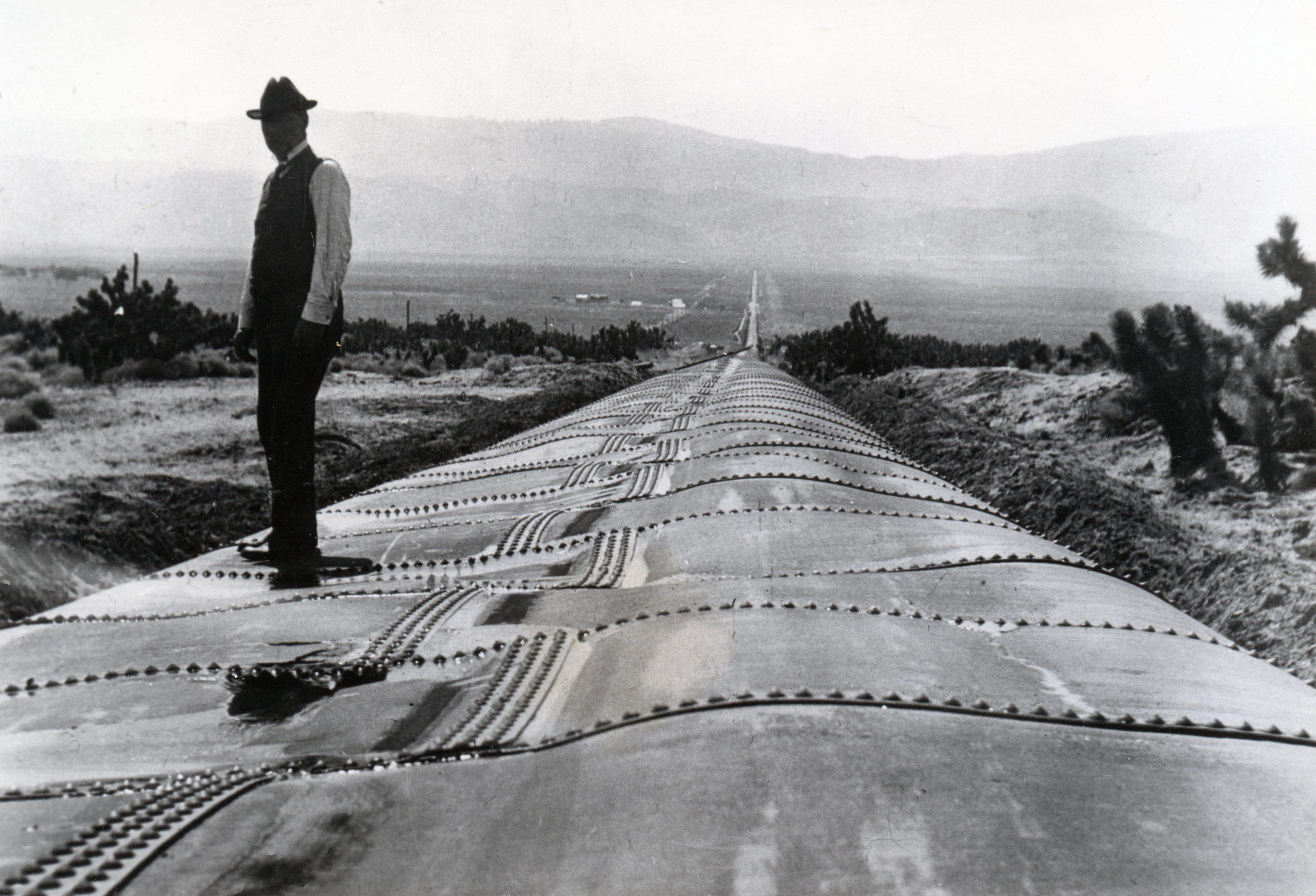 |
|
| (1914)*^ – View showing William Mulholland standing on a section of the Antelope Siphon damaged by a major flood. Note: Water pressure alone would restore the pipe to its original circular form. |
Historical Notes The damage to the Antelope Siphon was repaired by the simple expedient of turning the water on after the break was mended, relying on the pressure to restore the pipe to circular form. The hydraulic pressure, under gradually increasing head, restored the pipe to its original shape without breaking any of the joints or shearing the rivets, and a month after the collapse the siphon was as good as new. The total cost of repairing the siphon was only $3,000. It would have cost about $250,000 to take it apart and rebuild it.^^ |
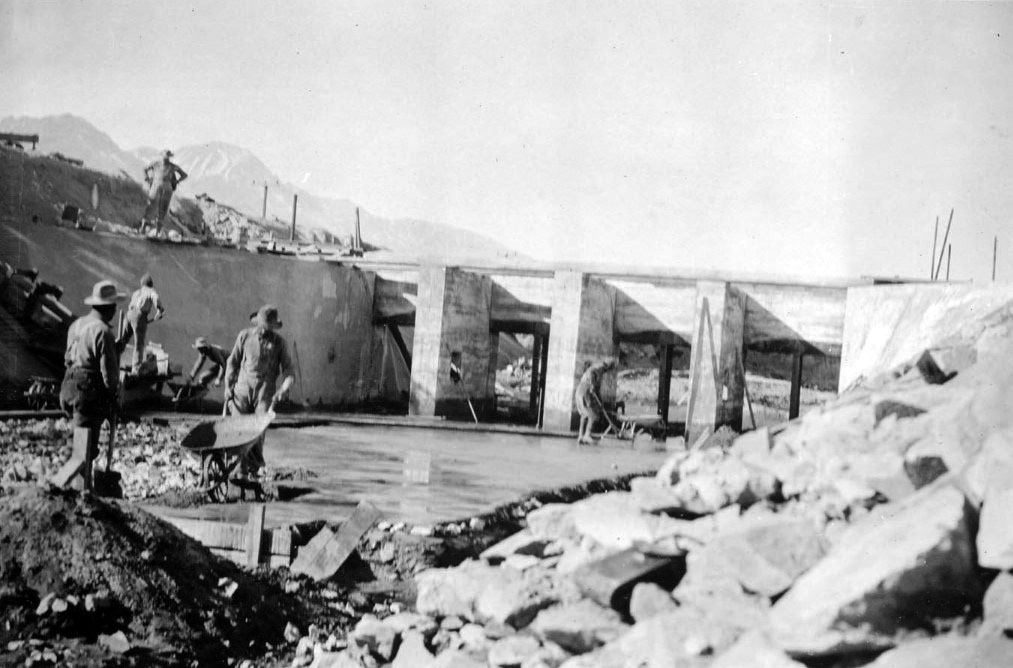 |
|
| (1912)^*# – View showing workers constructing the regulating gates at the main canal in Owens Valley. |
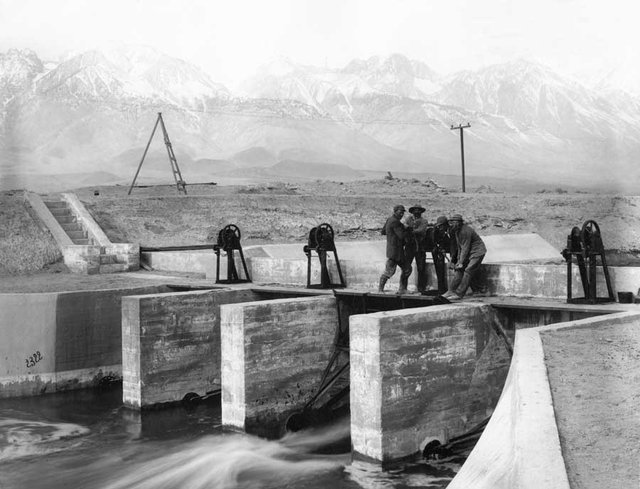 |
|
| (1913)*#* - Workers raising the gates at the intake near Aberdeen in Owens Valley. |
Historical Notes On February 13, 1913, water was officially released into the aqueduct to flow south toward Los Angeles.*#* |
(ca. 1908)**^ - Map showing the full extent of the 233 mile long Los Angeles Aqueduct running from its intake in Owens Valley to the point at which the water cascades down into the northeast San Fernando Valley.
|
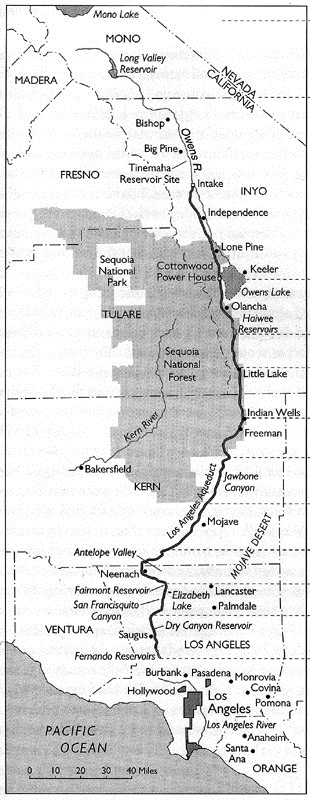 |
.jpg) |
|
| (October 16, 1913)* - The gates are opened to allow water to cascade down above the San Fernando dam during a dual test and photo opportunity for the new Los Angeles Aqueduct before the opening ceremonies. |
The Aqueduct is Officially Dedicated
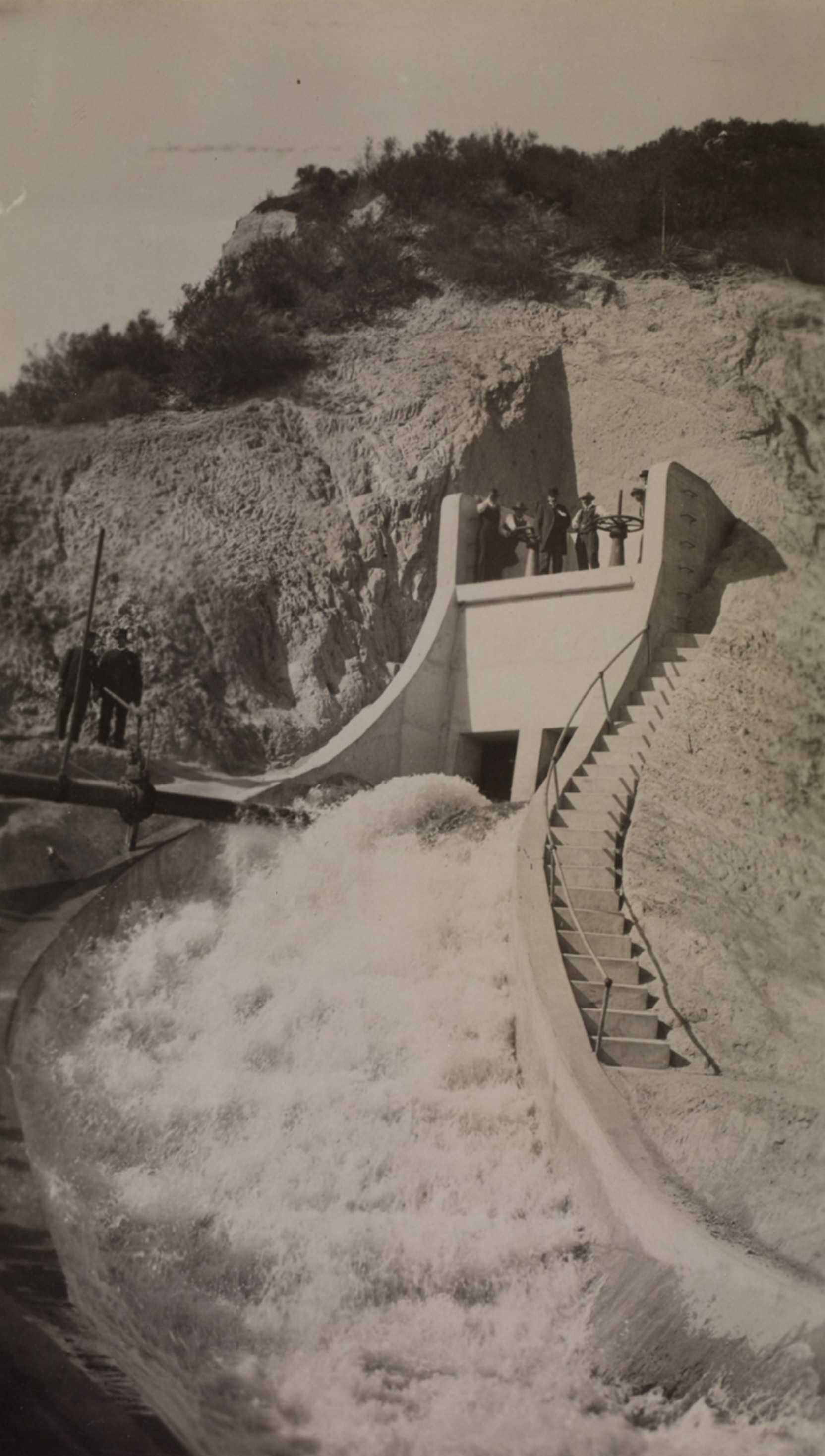 |
|
| (1913)* – Opening of the Los Angeles Aqueduct headwater gates at Sylmar during the November 5 dedication ceremony. Among those at the wheels was H. A. Van Norman, Owens Valley division engineer and namesake of today's Van Norman Reservoir. Others included Roderick Mackay (chief construction engineer), D. L. Reaburn (Saugus division engineer), A. C. Hansen (Jawbone Division engineer), and Adna R. Chaffee, Jr. (U.S. Army). Photo from the Ernest Marquez Collection. |
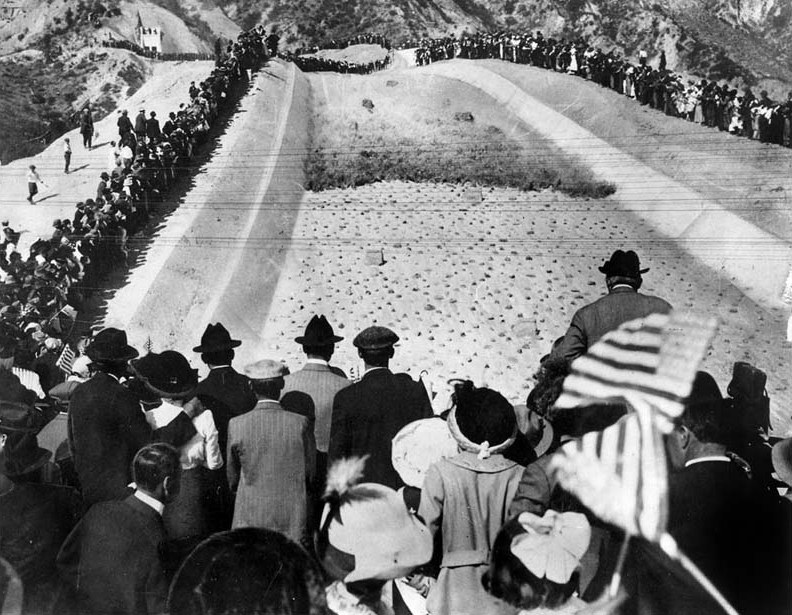 |
|
| (November 5, 1913)*# - Men, women, and children stand in awe as water is released from the gates at the top of the cascades. Many of the spectators are waiving American flags. Wiliam Mulholland can be seen at right-center of photo just above the American flag. |
Historical Notes Over 30,000 Los Angeles residents came to the San Fernando Valley to see the opening ceremony of the Los Angeles Aqueduct, where the first water from the Owens Valley completed its journey to Los Angeles. William Mulholland presided over the ceremony and called out for the water gate to be opened with five of the most famous words in Los Angeles history: ''There it is, take it". |
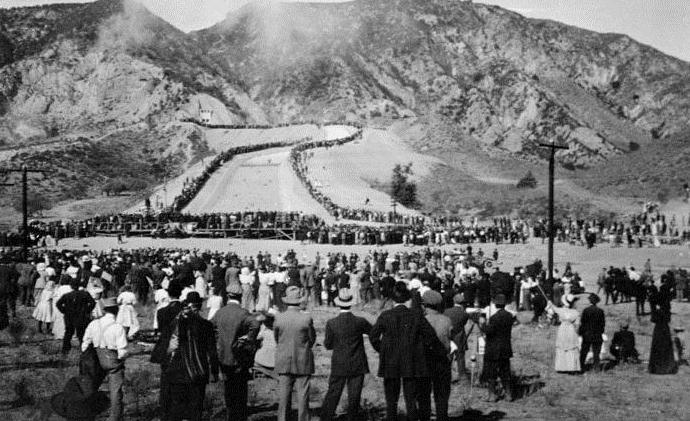 |
|
| (November 5, 1913)* - Crowds watch as the water gates are opened and the Los Angeles Aqueduct water starts to flow down the cascades into the San Fernando Valley. |
Construction of the LA Aqueduct Video
Click HERE to see a short (5 min.) video titled: 'The Great Los Angeles Aqueduct' |
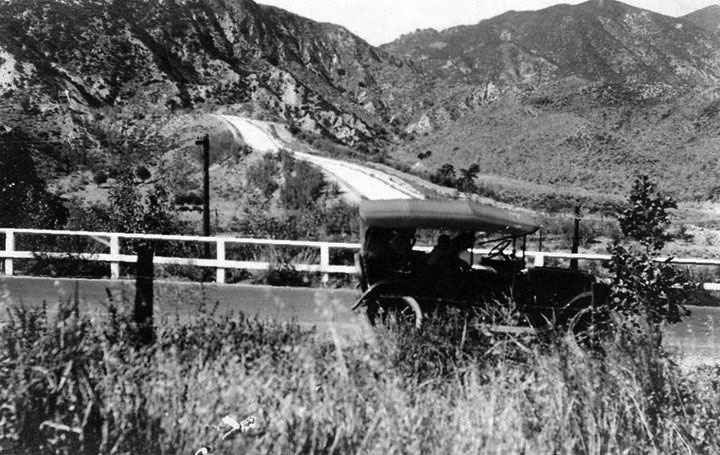 |
|
| (1915)* – An early model car traveling past the terminus of the Los Angeles Aqueduct in present day Sylmar just south of Newhall Pass in the San Fernando Valley. The aqueduct had been completed by William Mulholland two years earlier in November 1913. The road in photo is likely the predecessor to Highway 99 and Interstate 5 heading towards the Ridge Route between Los Angeles and Bakersfield which had just been completed the same year of 1915. |
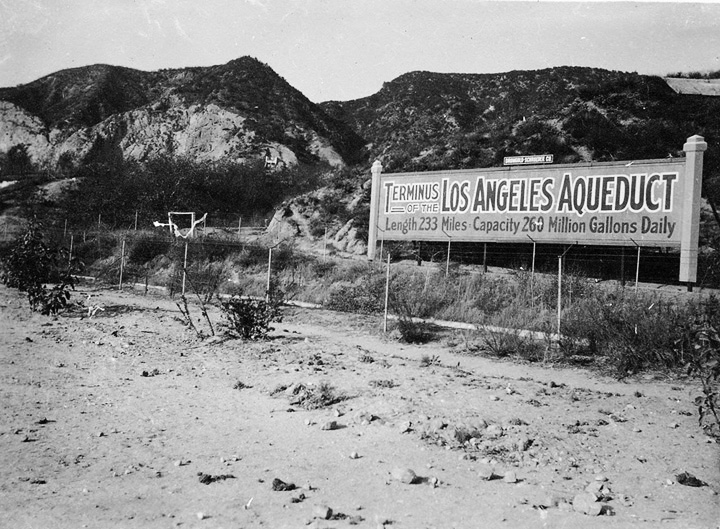 |
|
| (n.d.)^# - Terminus of the Los Angeles Aqueduct - This photograph shows a sign advertising the terminus of the Los Angeles Aqueduct, which had been completed in November, 1913. The sign was located near where present day Interstate 5 runs just east of the Van Norman Reservoir in Sylmar. In the background to the North are the San Gabriel Mountains, just east of the Newhall Pass. To the left of the sign can be seen the original water cascade that marked the terminus of the Aqueduct. The sign states "Terminus of the Los Angeles Aqueduct. Length 233 Miles. Capacity 260 Million Gallons Daily". |
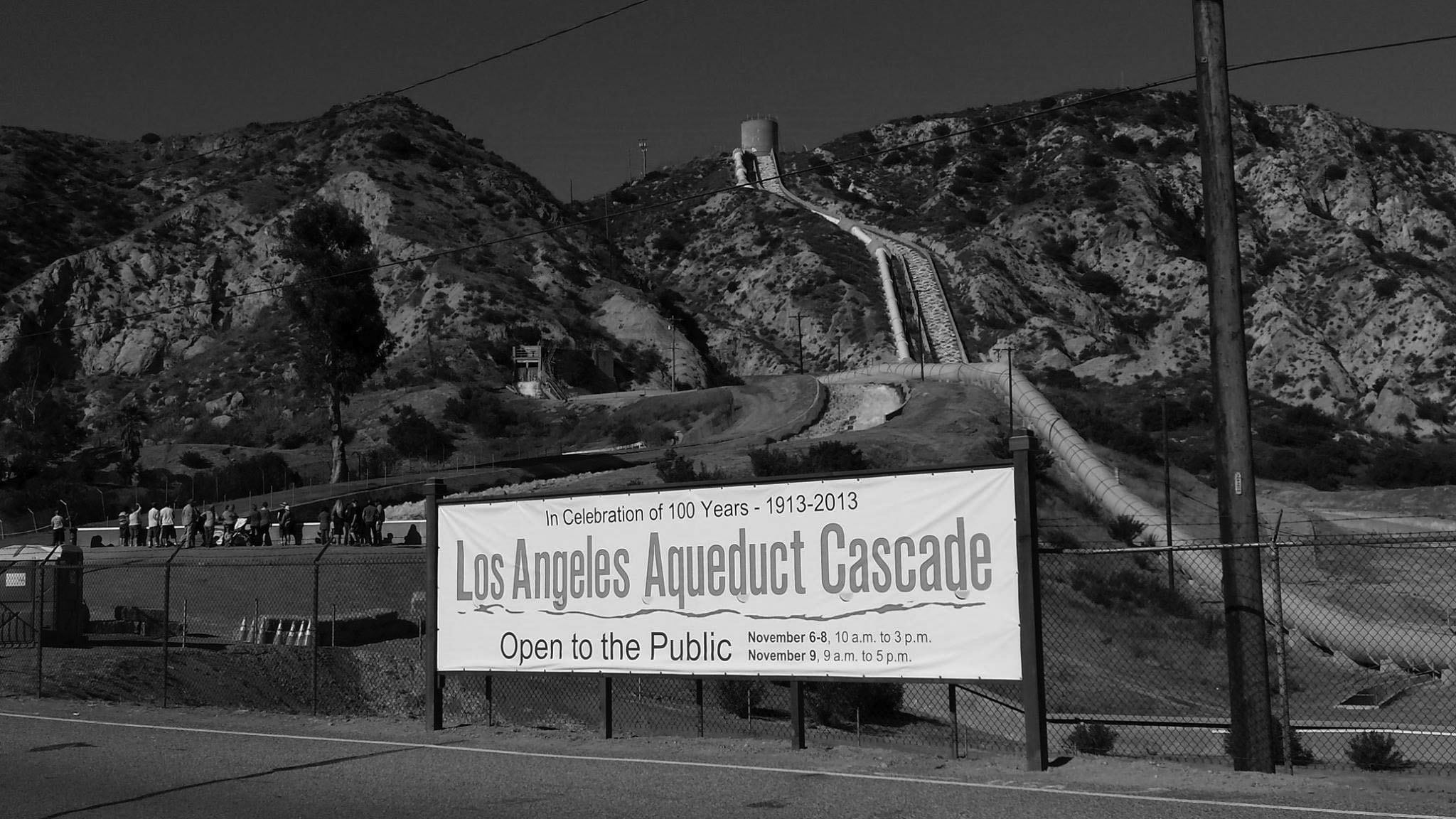 |
|
| (2013)^** - View showing visitors at the foot of the original Los Angeles Aqueduct Cascade on its 100 year anniversary (left). The cascade for the Second Los Angeles Aqueduct (completed in 1970) is on the right. |
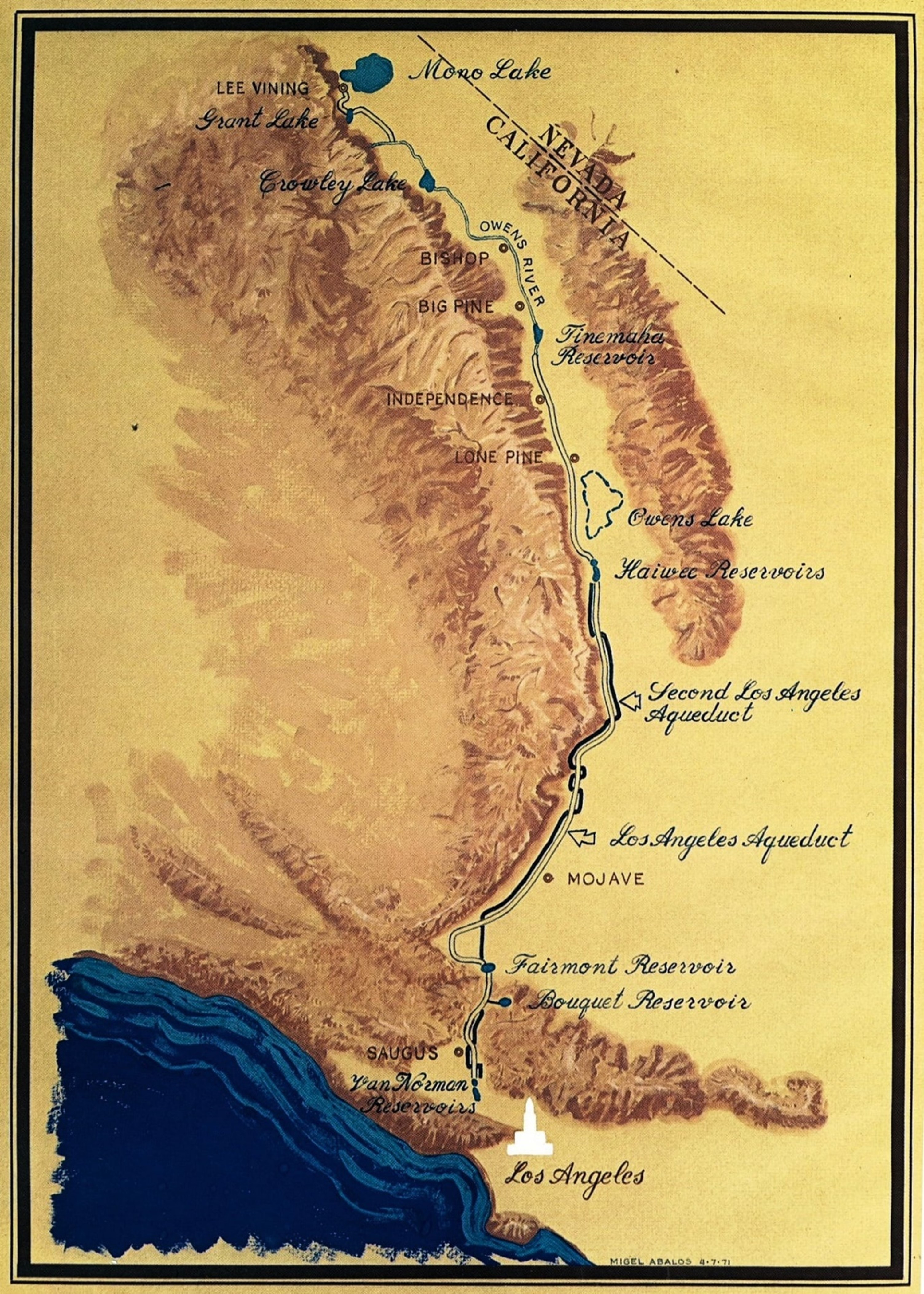 |
|
| (1971)* - Schematic map of the Los Angeles Aqueduct by Migel Abalos. |
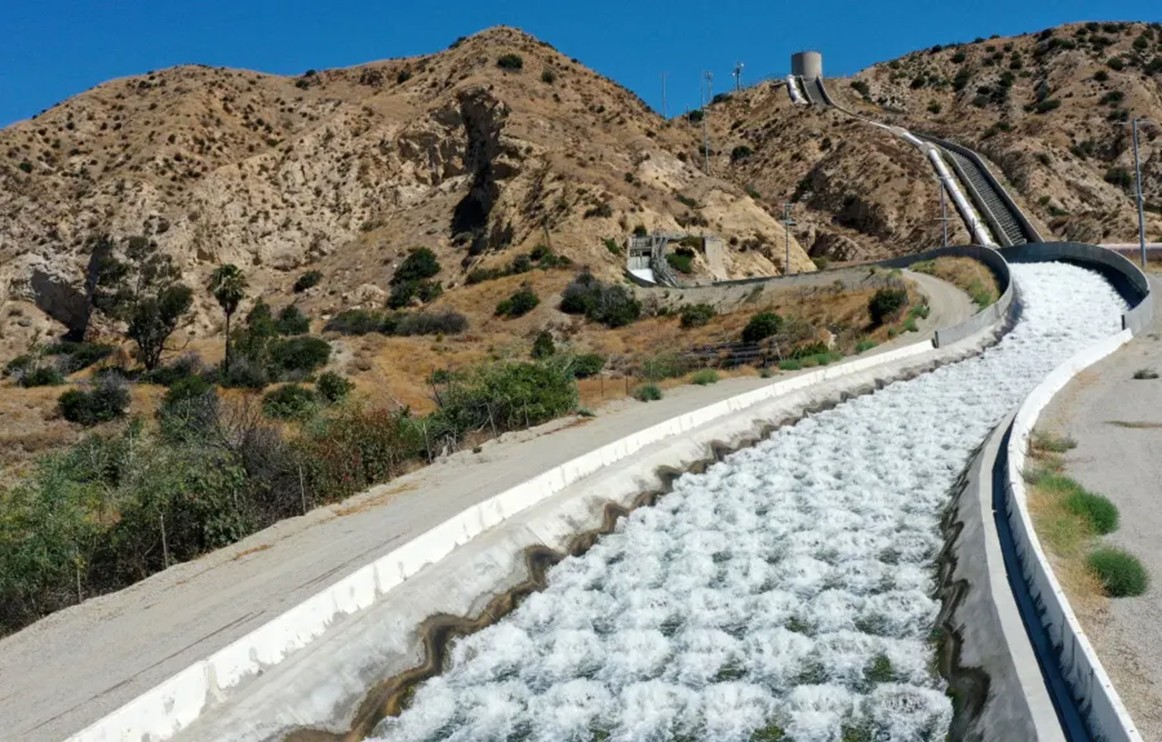 |
|
| (2022)* - Water flows down the Original Los Angeles Aqueduct cascade (left) at Sylmar, while the Second Aqueduct cascade (right), with its surge tank and penstock pipe above, remains dry. This contrast highlights the system’s flexibility—when hydroelectric plants are running, most water bypasses the cascades and flows through the penstocks for power generation and reservoir delivery. Photo by Dean Musgrove, Los Angeles Daily News/SCNG). |
Historical Notes In typical operation, the hydroelectric plants handle the full volume of incoming water, so most or all water bypasses the cascades and flows through the penstocks for power generation. This is the most frequent condition, making water flowing down the cascades an occasional event rather than a daily occurrence. The cascades thus serve as an overflow channel, ensuring operational flexibility and system safety during rare periods of maintenance, repairs, or unusually high water flow. Click HERE to see more on the Second Los Angeles Aqueduct. |
Historical Background Video (w/Catherine Mulholland)
Click HERE to see a short (4 min.) video on the Construction of the Los Angeles Aqueduct |
Los Angeles Aqueduct History and Photos |
* * * * * |
Please Support Our CauseWater and Power Associates, Inc. is a non-profit, public service organization dedicated to preserving historical records and photos. We are of the belief that this information should be made available to everyone—for free, without restriction, without limitation and without advertisements. Your generosity allows us to continue to disseminate knowledge of the rich and diverse multicultural history of the greater Los Angeles area; to serve as a resource of historical information; and to assist in the preservation of the city's historic records.
|
History of Water and Electricity in Los Angeles
More Historical Early Views
Newest Additions
Early LA Buildings and City Views
* * * * * |
References and Credits
* DWP - LA Public Library Image Archive
^ YouTube - Construction of the Owens Valley Project
^^LADWP Publication: The Story of the Los Angeles Aqueduct
^*Santa Clarita Valley History in Pictures (Photo Credit - Alan Pollack)
^#OwensValleyHistory.com: Terminus of the L.A. Aqueductt; Antelope Valley; Cement Mill; Steam Shovel No. 1
*#Skyscraperage.com - LA Times: June 18, 1911 LA Aqueduct
**#California State Library Image Archive
^*#Calisphere: University of California Image Archive
^#^Construction Photos of Joseph Barlow Lippincott
^^*L.A. Aqueduct Centennial 2013
*#*Virtual Transportation Museum
*^^A History of the San Fernnando Valley: lahistoryarchive.org
^^^California Museum: Today in CA History
*^*Wikipedia: Cowley County Historical Museum - Caterpillar Tractor Photo; Monolith, CA
**^William Mulholland and the Rise of Los Angeles by Catherine Mulholland
< Back
Menu
- Home
- Mission
- Museum
- Major Efforts
- Recent Newsletters
- Historical Op Ed Pieces
- Board Officers and Directors
- Mulholland/McCarthy Service Awards
- Positions on Owens Valley and the City of Los Angeles Issues
- Legislative Positions on
Water Issues
- Legislative Positions on
Energy Issues
- Membership
- Contact Us
- Search Index